





‘Book Talk’ program invites older adults to connect through reading Aaron Walker - Moose Jaw Express
For many older adults, finding meaningful social connection can become increasingly difficult as workplaces fade into memory, children grow busier, and everyday routines become quieter — but a new monthly program hopes to change that one conversation at a time.




Launched through Age-Friendly Moose Jaw in partnership with the Moose Jaw Public Library (MJPL), the Saskatchewan Seniors’ Mechanism, and the Moose Jaw and District Senior Citizens Association, “Book Talk” will run on the second Thursday of each month from October through February 2026.
Each session is offered from 10:30 to 11:30 a.m. in the Timothy Eaton Centre lounge and the concept is simple: show up at no cost, sip free coffee, enjoy complimentary snacks, and talk about books.
“Isolation can be a big factor for older adults in our community, and programs like this really help bring them together so they don’t feel so isolated,” said Age-Friendly Moose Jaw older adult program co-ordinator Sky Klein.
Guided by James Miller, a library technician with the MJPL, each session is designed to be friendly, casual, and open to anyone. Each meeting can work as a standalone session and is offered on a come-and-go basis. “There’s no need for anyone to sign up — just come on in,” Klein said.
Each month highlights a different genre, beginning with historical fiction on Nov. 13 and leading into non-fiction on Dec. 11, mystery on Jan. 8, 2026, and classics on Feb. 12, 2026. Participants are encouraged to

bring any book of their choosing that fits the monthly theme and share what they’ve been reading, explain why they enjoyed it, and offer recommendations to others.
“(You can bring) any book that would be associated with the genre (for that month),” Klein said. “Hopefully you can get other people to read your favourite historical fiction (book), and you might find some new (books) that you would like to read as well.”
Klein, who started with Age-Friendly Moose Jaw in September, is looking forward to her first session.
“Honestly, I love reading. I’ve been a very big reader my whole life, so I’m really excited to go in and see what kind of books
everybody has been reading,” she said. “I can’t say historical fiction is my favourite (genre), but I’m always up for a good recommendation.”
The lounge can accommodate up to 40 guests, and while Klein wasn’t present for previous rounds of the program, she hopes to see strong turnout at her first session on Nov. 13. She recommends guests arrive five to 10 minutes early to facilitate a few introductions.
Intergenerational programming
For those interested in additional program options for older adults, Age-Friendly Moose Jaw is currently working to expand intergenerational programming that matches older adults and local students for crafts, cards, board games, pickleball, and more. Klein is currently gauging interest from the community before these programs proceed.
“We’ve partnered with the MJPL and the Timothy Eaton Centre to offer crafts … (and) things along those lines for kids and seniors to interact together,” she said. “I’m having a hard time getting seniors interested, so I just need to get the word out there.”
Residents aged 55 and older who are interested in future intergenerational programs can contact Klein at Age.Friendly. MJ.Programming@gmail.com or by phone at 306-690-4048.
No registration is required to attend Book Talk sessions. The Timothy Eaton Centre is located at 510 Main Street North and can be reached at 306-694-4223.
For more information about Age-Friendly Moose Jaw, located at the same address, visit AgeFriendlySK.ca.
Finances, tariffs, trade, policing and addiction treatment were on the menu during a recent political “fireside chat” breakfast.
Roughly 60 people attended the Moose Jaw North Constituency event at the Grant Hall Hotel on Oct. 31, where MLAs Tim McLeod and Jim Reiter discussed issues affecting Saskatchewan.
Present financial position
“We are very fortunate in Saskatchewan. We have so much potential here. We’ve got what the world wants,” the Hon. Jim Reiter, responsible for five portfolios, including finance, said.
What Saskatchewan has is agriculture, potash, uranium and copper, with the world’s largest potash mine being built near Saskatoon, Cameco helping build nuclear reactors in the United States, and a new copper mine opening in the north, he continued.
The province is “well-equipped” in the long-term, but it faces “headwinds” in the short-term, as it went from having a balanced budget to a deficit due to forest fires, tariffs and lower oil prices, Reiter said.
However, Saskatchewan is the most well-equipped province in Canada to weather that deficit because it has the best credit rating and the second-best net debt-to-GDP after Alberta, he continued.
The main risk Saskatchewan faces is political — at the domestic level and


“The world has gone crazy when it comes to tariffs right now. Free trade helps everyone,” he added. “As soon as you get into protectionism, people think it’s going to help them alone, and it doesn’t because of the retaliation.”
Meanwhile, the Sask. Party government is more optimistic about the current Liberal government than the previous one, as Prime Minister Mark Carney is saying “a lot of the right things,” but those words require action, Reiter said.

The deputy premier noted that provincial politics are also a risk, saying the Opposition NDP is “definitely not free traders and are not business friendly.” He added that business drives the economy, while the corresponding growth pays for new schools and hospitals.
Diversifying invest-
Protectionism — including provincial trade barriers — does not work, while free trade builds wealth,
he continued.
Meanwhile, the government recently constructed a new men’s correctional centre in Saskatoon, while it plans to build a women’s correctional centre in Regina, McLeod said. This provides space to handle the people entering the justice system.
The government understands that crime has underlying behaviours, with many issues stemming from drug addiction, he noted. Moreover, many citizens know friends or loved ones who struggle with addiction.
So, the province has added 500 beds so people can make “the easy choice” and pursue voluntary addiction treatment, while they can self-refer and begin their “road to recovery,” he continued.
The government is also moving to a “recovery-oriented system of care,” where patients will receive complete wrap-around support that meets their needs, McLeod remarked.
Reiter said. That is why, to help businesses, the province has opened nine trade offices around the world.
Moreover, Premier Scott Moe travelled to China to ask its government to remove its tariffs, while there have been other worldwide mini-trade missions to keep doors open, he pointed out.
“The future is bright … ,” Reiter added.
Asked about how his portfolios connect, the Hon. Tim McLeod said corrections, policing, public safety and justice are “one big ball of justice.” Furthermore, policing leads to the court system, which leads to corrections, so an investment in one is an investment in all.
Continuing, he said the government wants to create safer environments, a commitment it takes “very seriously.”
This is why the province is funding 100 more officers for municipalities — including eight in Moose Jaw — and 70 Marshalls to respond to “hotspots” in Saskatchewan.
Furthermore, while Ottawa recruits and trains RCMP officers, the province has set aside money for 186 more members since it pays 70 per cent of their salaries, McLeod said.
More officers mean more arrests, so the province is adding more civilian court prosecutors to handle cases and creating court hubs to hold more trials,
“We’re trying to make safer communities so we can have a strong and bright future for our families and our citizens,” he added.
The provincial government understands the pressures citizens are facing with affordability and inflation, although there is “no panacea” to fix it, said Reiter. These problems aren’t unique to Saskatchewan but affect Canada and the world.
So, in the recent Throne Speech, the Sask. Party government decided to tackle affordability by ensuring people keep more of their money, he continued. One big change is to income taxes, as families will save $100,000 over the next four years.
“Nobody knows how to spend your money better than you … . It shouldn’t be the government dictating that,” Reiter added.
McLeod said new legislation will “crack down harder” on drug manufacturers and traffickers and hopefully prevent them from introducing “harmful poisons” into communities.
He added that “compassionate care legislation” will also force some people into treatment who, because drugs overpower their rational thinking, refuse to pursue recovery.



By Joyce Walter Moose Jaw Express
If city council and city administration pay attention to the results of the recent Prioritizing Our Future survey, it should be noted with dismay that only 1.49 per cent of the city’s population cared enough to answer the 33 questions posed.
Last year’s survey had 700 respondents while only 522 responded this year, begging the question of why there’s reduced interest among taxpayers in offering opinions and suggestions about the quality of life in Moose Jaw. Was September not a convenient month for a survey? Is there a feeling that no one at city hall is listening? Were the questions relevant and was there an incentive offered for participation?
A community west of here had the right approach to its community survey. Guests paid for their supper at the door and were then given a survey sheet. Only
when the completed survey was turned in were the pie tickets handed out. Those survey sheets were returned in short order.
Forty-eight per cent in the Moose Jaw survey said their quality of life in Moose Jaw is excellent or good, up from 30 per cent saying that last year.
Customer service at city hall, recreation programming and the city’s website received ratings of excellence. But not so favourable were ratings given for maintenance and beautification of green spaces, water and sewer services, the five-day-a-week transit service, fiscal management and SAMA’s assessment practices.
It is somewhat ironic that some respondents want the city to offer more opportunities for citizens to offer their feedback. If only 1.49 per cent of the citizens take time to answer a few questions in an an-
nual survey, just what does council and the administration have to do to get more people interested in the community, beyond their own backyards? Incentives of pie might not be practical but a free bus ride might be manageable in response to completed surveys.
Despite the numerous complaints on social media, it appears the majority of citizens either don’t care about their community or can’t be bothered to participate in a survey. Or are they content to let the city council they elected make important decisions on their behalf?
We know that local residents have opinions and care about their city. Unfortunately the survey results do not reflect that interest.
Joyce Walter can be reached at ronjoy@saktel.net
Terence (Terry) George Coleman, a former city councillor, police chief, and civil servant with the Saskatchewan Party government, has died at age 79.
Coleman died on Oct. 23 in High River, Alta., while his funeral service was held there on Nov. 7.
The Moose Jaw Police Service, “with heavy hearts,” recently announced his death on Facebook, while his family posted his obituary to Remembering.ca.
Coleman was born on March 16, 1946, in Uckfield, Sussex, England, and moved to Calgary in the mid-1960s to work for the Bank of Montreal, his obituary said.
He later joined the Calgary Police Service and held various roles, while he was instrumental in starting the first Safer Calgary unit and bringing Crime Stoppers to the city, the obit continued. Furthermore, he received many promotions and awards, including the Order of Merit for Policing.
Coleman also headed numerous units during his career in Calgary, ending as the inspector of professional standards and director of human resources for the 1997 World Police and Fire Games.
From 1998 to 2004, Coleman was chair of the Criminal Intelligence Ser-

of the association’s HR subcommittee on police/mental health. He was also a member of the Institute of Public Administration Canada–Saskatchewan.
Coleman became police chief in Moose Jaw in 1997, and during that time, he earned two master’s degrees and a PhD, before retiring in 2007 after 34 years in policing, according to his obit, a CBC article and the province’s website.
He was then appointed deputy minister of corrections, public safety and policing in the newly formed Saskatchewan Party government, according to Hansard and the province’s website. He held that role from Nov. 27, 2007, to Nov. 21, 2008, when he became deputy minister of municipal affairs.
ment people gave him to run for mayor. However, he decided against running for a second time, saying that while it was a “difficult decision,” it was time to leave based on personal reasons and other opportunities.
“Decisions I have made and been part of were not based on a personal narrow agenda but were positioned to ensure that Moose Jaw is progressive; to be that which we expect and desire of Moose Jaw — a great place to live, work and to play, not only for today but also tomorrow,” he wrote.
“… We must all remember that there is no such thing as being able to stand still in a dynamic environment,” he added.
vice Saskatchewan, and the president of the Saskatchewan Association of Chiefs of Police from 2004 to 2007, according to the Saskatchewan government.
Furthermore, he was a director of the Canadian Association of Chiefs of Police (CACP), a member of the CACP’s human resource committee and co-chair
Coleman served as a city councillor from 2009 to 2012, but decided against running for a second term, despite support from family and friends, along with encouragement to run for mayor, news reports at the time said.
Coleman issued a letter on Sept. 17, 2012, saying he appreciated and valued the community support he’d received during his three years as councillor, while he was pleased to help plan Moose Jaw’s future. Moreover, he said he appreciated the support and encourage-
After moving back to High River, Coleman took on consulting jobs that took him around the world, either lecturing or investigating, his obituary said.
When his health started to fail, he received a kidney transplant and enjoyed his remaining time with family and friends, the obit added. In 2024, health issues slowed him down, but he continued to join his coffee crowd at Colossi’s, take day trips with his family, and spend time with his partner, Linda.
To send condolences, visit www. snodgrassfuneralhomes.com.
Aaron Walker - Moose Jaw Express
Square One Community Inc. will host its fourth annual “Empty Bowls” fundraiser on Thursday, Nov. 14, at Zion United Church, offering guests a meal that supports local housing initiatives.
Doors open at 11 a.m., with soup served at 11:30 a.m.
Tickets cost $25 each and include soup, dessert, coffee or tea, and a handcrafted ceramic bowl to take home. The event will also feature a silent auction, a staycation raffle, and an operational update from Square One co-ordinator Maxton Eckstein. Proceeds will help fund the organization’s supportive housing program.
“Right now we are at full capacity … the whole point of what we do is providing wraparound services, so it needs to be of high quality. We need to ensure that we have a good clientto-worker ratio. We need to raise funds so we can get more staff for that to happen,” community advocate and organizer Della Ferguson said in an earlier interview.
Tickets can be purchased with cash or by e-transfer with your name, phone number, number of tickets, and the word “bowls” to CommunitySquareOne@gmail.com. To learn more, visit SquareOneHousingMooseJaw.com. Zion United Church is located at 423 Main Street North.
For more information, see the earlier story on Page A9 of the Wednesday, Nov. 5, 2025, edition of the Moose Jaw Express titled “‘Empty Bowls’ fundraiser returns Nov. 14 to aid supportive housing program.”

TUESDAY, NOVEMBER 18
~ Houston Pizza
117 M ain St r e e t No r th, M
Ja w 6:30pm (from the menu)
please join us for this 90 minute
~ i nv i te a f ri end o r f a mil y member as we l l ~ people make it a priority to look after their own arrangements. Find out how to control costs, provide peace of mind to your family and executor, and fund costs in advance (with a monthly payment or lump sum). Purple Shield Plans are customized to your wishes.
Si nce a comp l im e nt a r y m ea l will be provid e d, w e woul d r e qu e st h ea ri ng o f your pl an s to a tt en d b y ca lli n g Moos e Ja w Fu ne r a l H om e 30 6 . 69 3.455 0 Michael Penner

TUESDAY, NOVEMBER 25 th
~ Rodo’s Pizza Event Room
9 t h A ve
6:30pm (from the menu) th
By Patricia Hanbidge


If you are gardening in November in Saskatchewan, you are definitely not doing so outdoors. Thus, we need to ensure that we provide all of what is needed for good growth. As you know, plants need light, water, warmth, oxygen and food to grow appropriately. Also, as we live in the Northern Hemisphere, we need to provide supplemental light in order to produce any substantial amount of food from the plants that we grow. One of the best things about growing plants from seed is we then have the freedom to grow almost anything we desire! There is an amazing selection of different varieties and cultivars of plants that sometimes makes it rather
difficult for us to decide what we should grow. It is easy to get carried away and grow too much as this time of year we are craving green growth and those tiny little packets don’t seem to hold that much! It is only once those plants get growing, we see how a few seeds can easily grow into way too many plants! Instead of planting all the seeds in the package, only plant as many as you will need. Share the leftovers or store them in a cool, dry place.
If we are going to be successful starting seeds, it is useful to understand a little bit about the seed itself and what it requires to germinate. Seeds are made up of an outer seed coat that protects the inner parts of the seed during dormancy. Inside the seed coat lies the endosperm which serves as the food supply that is essential for the early growth of the seedling. In the center of the seed is the

embryo which is really a very minute undeveloped plant.
There are four things that seeds need to germinate. Water is essential for penetrating the seed coat which causes the endosperm to swell. The water dissolves nutrients in the endosperm which are then available to the embryo and life begins! Some seeds need light in order to germinate while others do not. Oxygen is also necessary as the seed needs to respire in order to break down those nutrients in the endosperm. Last but not least, germination requires heat. Each seed will have an optimum germination temperature for the best rate of growth.
If you are new to starting seeds, then choose to grow those plants that are relatively easy to germinate and do not need special conditions. Most seed packages will give directions on how to plant those specific seeds. At this time of year, I grow salad greens and herbs as those are the plants that I wish to have at my fingertips to enhance our diets. Generally, small seeds need not be covered with soil but instead gently pressed into the media or soil. Medium seeds can be lightly covered and large seeds can be poked right into the soil. A good rule of thumb is to plant the seed to the depth of their diameter.
Keep the soil moist to ensure even germination whether you are seeding indoors or directly into the garden. Use a gentle spray to avoid washing the seeds around, or they may pool into dense clumps. Keep the humidity high until the seeds germinate by covering seed pots with plastic wrap. Once you see the plants germinate, uncover the seedlings to avoid conditions that are too wet for the new seedlings.
Once the seeds germinate those young seedlings will need adequate light in order to grow. Placing them directly under a fluorescent light fixture or grow light will ensure that the seedlings are strong and sturdy. If you find that your seedlings are tall and spindly it is because they are not getting enough light and are reaching for the sun.
Hanbidge is the Lead Horticulturist with Orchid Horticulture. Find us at www.orchidhort.com; by email at growyourfuture@gmail.com on facebook @orchidhort and on instagram at #orchidhort.
Tune into GROW Live on our Facebook page https://www.facebook.com/ orchidhort or check out the Youtube channel GROW… https://www.youtube.com/channel/ UCzkiUpkvyv2e2HCQlFl0JyQ?
Thirteen-year-old Sydney Eberle continued her tradition of giving back by donating to the Moose Jaw Humane Society’s “Paws for Pledges” radiothon for the third year in a row.
She stopped by the shelter on Nov. 7 to present a $150 donation raised through her home-based enterprise, Simply Scrubs.
“We donated to help the animals out because they needed some money to get supplies,” she said.
Sydney and her grandmother, Barb, have been crafting and selling handmade body scrubs for the past two years. A portion of every sale goes toward local charitable causes, with proceeds safely tucked away until there’s enough to give back.
“We take the leftover money that we make from Simply Scrubs and put it in a little bag until we get enough to donate,” Eberle explained.
The young entrepreneur said she and her grandmother now have more than 130 scented scrubs ready for the holiday season, with plans to continue supporting local charities from their profits.
“We have a Christmas scrub sale coming up, and

we have a lot of Christmas (themed) scrub (scents),” her grandmother said. “We (also make our body scrub products) all year long for anybody who wants one.”
Sydney’s gesture added to the excitement at the
shelter as community members rallied throughout the day for the radiothon. Hosted in partnership with a local radio station, the 12-hour broadcast is the Humane Society’s largest annual fundraiser, aiming to raise $90,000 to support shelter operations this year.
Fundraising co-ordinator Kelsey Leschasin said in an earlier interview that the event helps fund food, medical care, and supplies for the hundreds of animals that pass through the shelter each year.
For Sydney, who has previously donated to both the Humane Society and the Dr. F.H. Wigmore Regional Hospital, it’s simply about helping where she can.
“It just makes me happy that the animals can get the stuff that they need,” she said.
The Moose Jaw Humane Society is located at 1755 Stadacona Street West and can be reached at 306-6921517. Although the radiothon has concluded, residents can still make donations online at MJHS.ca.
To help support Eberle in her charitable enterprise, visit her Facebook page, “Simply Scrubs.”






A prisoner who accused court officials of having a conflict of interest with his trial must submit a formal application if he wants his allegation to be official, a judge says.
During an appearance in Moose Jaw Provincial Court on Oct. 21, Judge David Chow found Ryan Scott Milne guilty of three counts of dangerous driving to cause bodily harm, one count of assault with a weapon (a truck), one count of assault with a weapon (baseball bat) and one count of uttering threats to cause death.
However, Milne gave a profanityladen outburst and said he refused to accept the decision and would appeal to the Saskatchewan Court of Appeal. He also accused Robbie Parker of having a conflict of interest — he never specified what it was — in being the Crown prosecutor on the case and trial.
The Crown and defence then set

Jason G. Antonio - MooseJawToday.com
Thursday, Nov. 13, as the date for sentencing submissions.
Judge Chow had the parties return to court on Nov. 7 so he could address Milne’s “informal” accusation against Parker about the alleged conflict of interest. The judge noted that the man also made similar claims about conflicts of interest to his previous lawyers.
“No application is before me seeking relief in this regard,” Judge Chow said.
Continuing, the judge said that after he sentences Milne, he would be “functus officio,” meaning the matter would no longer be in his hands and he could not “entertain a request for relief in this regard.”
Judge Chow said he was formally notifying Milne and defence lawyer Olamide Ben-Ajayi that any allegation Milne made about or that could impact the fairness of his trial must be made


properly. This meant they had to submit a formal application to the court, laying out the allegations in an affidavit form, and describing the relief — or outcome — they want and the authority that could grant the relief.
Ben-Ajayi said he understood what the judge was saying, while Milne said he did not comprehend the situation. The judge replied that he could discuss the matter with his defence lawyer afterward.
“From our discussions, I am not in a position to bring an application based on what he has told me,” Ben-Ajayi said. “ … as far as I am concerned, I do not see much substance in what he has told me.”
Parker spoke up, saying he had concerns about what Judge Chow just said, specifically, that he had highlighted the issue and brought it to the attention of the court, Milne, and his lawyer instead





of making an application on their behalf.
“I certainly understand what you’re saying. You want the issue to be dealt with knowing there’s going to be an issue in advance of the sentencing … ,” Parker added.
In response, Judge Chow said he didn’t want a situation where Milne appealed the trial verdict and said that he had raised a conflict of interest — informally or otherwise — that “comprised” the trial’s fairness and that the judge did nothing.
Milne, speaking by video, said, “And it will be brought up in my appeal.”
“It’s fine” that Milne plans to appeal this issue through the correct process, the judge said, but until he has received a formal application, the date for sentencing submissions would still happen on Nov. 13.









The Palliser Regional Library board approved a 2.27 per cent rural levy increase for 2026 during its annual general meeting on Nov. 1, citing flat provincial funding, inflationary pressures, and a provincial funding formula that officials say disadvantages regions with strong collections and high rates of resource sharing.
“In 2025-26, the regional grant pool received an increase of zero per cent from the provincial government,” Arwen Rudolph, Palliser’s director said during the budget presentation. “It was a really hard budget. I started out with thousands of dollars in the hole and I had to attack quite a few things to make it work. If we don’t get an equity increase next year, it’s going to be possible cuts to staffing services. There’s nowhere else to cut from — we’re running as lean as we possibly can.”
Under Palliser’s structure, the increase represents about 35 cents per capita and raises the annual amount rural municipalities must contribute to the regional library. Towns or villages with a branch will be required to pay 1.5 times the base levy, and towns over 2,000 residents will pay twice the base amount.
“In the last 11 years, we have only had an increase in two (of those) years,” Rudolph said. “We’ve had almost a 30 per cent cost of living increase (over that same period) and the regional grant pool has … only increased by about four per cent in that same period.”
To balance next year’s budget, Pal liser intends to trim some online services. Rudolph specified that the Niche Acad emy will be dropped in March 2026, and the library’s Ancestry.com subscription

will not be renewed in 2026. Hoopla will likely be reduced from five checkouts to “three or four.” “I don’t like to do this because Hoopla, especially, is a wellused and well-loved resource, but … I
heavily in their collections.
The formula also rewards branches with longer open hours, a rule created before digitization allowed usage statistics to be tracked electronically. Now, Rudolph argued that “using the resource sharing numbers makes more sense… than just using open (hours) numbers.”

side of that balance.
“We have the highest per capita materials expenditure in the province. We resource share more than anyone else, aside from the big cities, but we’re not getting credit for that … because of the way the funding formula is currently structured,” Rudolph said.
One representative urged regions to work together when approaching the province, arguing that divided messages are less effective. “To get government to change the size of the pie, it has to be everybody (working) together,” they said.
Rudolph agreed, noting that some regions currently benefit from the population-based formula and are therefore reluctant to support changes. “(Some regions) don’t want changes to the funding formula, because they’re doing okay on it, and any change would mean they are doing less okay on it,” she said.
Going forward, Palliser is pushing for a larger provincial grant pool and a revised funding formula that reflects digitized usage, resource sharing, and materials spending. That includes building a province-wide coalition, working with SUMA, publishing advocacy materials online, and pressing for updated metrics at the provincial level.


Population trends add further challenges. Growing suburbs around Regina and Saskatoon send their levy dollars to their home regions, but many residents use the large city libraries instead, leaving some regions overfunded while oth-
Palliser, she added, is on the wrong
“Our usage is very steady, and actually our total collection usage is going up,” Rudolph said. “This funding formula doesn’t reward us for having a great collection that people want to use and ship (to other regions).”
For more information and to read the full report once published, visit PalliserLibrary.ca.
The Palliser Regional Library’s summer reading club surged this year, with 9,011 guests attending 749 events across the region and participants logging a combined 832,169 minutes, or the equivalent of around 19 consecutive months of reading.
“We had a really amazing year for summer reading across the region. We had over 9,000 people attending the programs … which is a 46 per cent increase from last year,” assistant
Aaron Walker - Moose Jaw Express
director Brianna Miller said in her report during Palliser’s annual general meeting on Nov. 1. The logged reading minutes, she added, amount to a “35 per cent increase” from 2024.
Palliser tracks reading minutes as one way to measure engagement and program impacts. Minutes are tracked instead of books or chapters read, Miller reported, because it helps “level the playing field for differing reading levels and
Give Back to your Notorious Community and Apply for a Position on a City Committee or Board Today
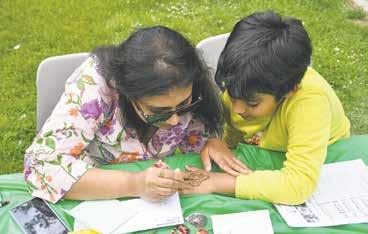
the region as attendance climbed 46 per cent this year.
Photo by: Aaron Walker
interests.”
Moose Jaw City Council is seeking passionate Moose Javians who want to make a positive impact within one of our City-led committees and boards.
If you are 18 years of age or older, a Canadian citizen, a full-time resident of Moose Jaw or the region, and have the knowledge, leadership and energy to make a difference, click the Boards, Committees and Commissions page at www.moosejaw.ca to find the committee, board or commission that aligns with your interests, including:
• Moose Jaw Municipal Airport Authority (MJMAA) - 3 region representatives & 3 Moose Jaw resident representatives
As a member, you will provide input and advice to City Councillors and other engaged residents that will help shape decisions on important issues that impact life in the City of Moose Jaw.
City Council values inclusivity, respect and trust and invites participation from community members in the decision-making process. Nominees will have been recruited through an inclusive, transparent, and equitable process and appointments made by City Council will reflect these objectives.
Deadline for completing applications is Friday November 14, 2025. For more information, you can also contact the Office of the City Clerk at cclerk@ moosejaw.ca or 306-694-4424.
“We have been really excited to see these numbers increase, but numbers are only a part of it. To understand the excitement and impact … we need to get down on the ground level and see the people enjoying it and what kind of programs the branches are doing,” she said.
In Moose Jaw, this summer’s reading club included themed programs featuring topics from “Around the World.”
To gather statistics, regional branches had the option to use paper reading logs, the Reader Zone app, and some chose to track minutes independently. The numbers reflect both reading that was done in groups during programming and reading that participants reported from home.
“Not all of our branches used it,” Miller said, noting
You cannot have a positive life and a negative mind.
-- Joyce Meyer
ents say they always appreciate having in-person events to promote literacy for their kids. One person said the Reader Zone app was fantastic and really helped them motivate their kids to read,” Miller added.
The regional library is also pushing to grow the program for attendees of all ages.
“We’ve been putting more of an effort into making summer reading clubs not just for kids, but for people of all ages,” she said. “All of our branches had programs for kids, adults, and (patrons of) all ages, so we’re really pleased with that.”
that some branches preferred to plan their own activities from scratch. For branches who were restricted in terms of available time or staffing, Palliser “put together a toolkit that has activities, promotional resources, resources for registration … to make things comfortable for them.”
Miller then pointed to a regional library survey delivered to each branch at the conclusion of this summer’s reading club program.
“The staff seemed to be really pleased with the amount of communication that they got from us. They said the resources we gave them were very helpful, and we got a few participants’ responses … every respondent said the program increased their enjoyment of reading.
“This summer, we had par-
In regions where program registrations faced any sort of difficulties, Miller said staff will collaborate on tailored approaches.
“For next year, we’re going to work with (these specific branches) and see if we can find some creative solutions that might help them meet the needs of their specific community,” she explained. “What works in one place might not work as well in another … and for some of them, a win is like 10 kids (attending a program).”
Within Palliser, the Moose Jaw Public Library led the way with 405,559 recorded minutes, followed by Avonlea Branch Public Library with 74,640 minutes and Tugaske Branch Public Library with 65,022 minutes reported at the meeting.
For more information, visit PalliserLibrary.ca or MJLibrary.ca.


Intellectual freedom remains a defining pillar of the public library system, operating under the belief that communities are strongest when residents can access information from all sides — even when access to that information is unpopular.
That message was reinforced by Stephanie Jeanes, archives and adult program librarian at the Moose Jaw Public Library (MJPL), during the Palliser Regional Library’s annual general meeting on Nov. 1.
Her presentation, prompted by a recent rise in book and program challenges, aimed to reinforce the policies and legal standards that protect open access in public libraries.
“Two basic tenets of librarianship are intellectual freedom and (that) we share everything,” Jeanes explained. “Intellectual freedom refers to the right of everybody to seek, receive, and impart information and ideas from all points of view, and intellectual freedom is a core part of our profession. We believe that a well-functioning democracy relies on informed citizens who can look at things from different perspectives, and exposure to different viewpoints can foster debate, reflection, and intellectual growth.”
Jeanes stressed that acquiring material does not mean librarians agree with it — only that residents have the right to decide what to view for themselves.
“We also need to remember that providing access is in no way the same as endorsing ideas that we chose to include … but rather, we make them available to those who are interested,” she said.
Those values are grounded in legal frameworks. Jeanes cited both the Universal Declaration of Human Rights, which states that everyone has the freedom to seek and receive information, and the Canadian Charter of Rights and Freedoms, which protects freedom of expression, belief, and thought.
“It’s our responsibility as library professionals to support, defend, and promote intellectual freedom, and it’s also our professional obligation to hold this as a human right,” she explained. “So censorship — whether that’s removing books or restricting access to them — really goes against the core mission

of libraries and the core values of our profession.”
Borrowing records are protected by strict confidentiality policies, and privacy rights apply to anyone age 14 and older. Decisions about account access require prior consent.
Jeanes noted that school libraries operate under an in loco parentis framework, allowing divisions to limit materials based on age and curriculum. Public libraries, by contrast, do not assume a parental role, and decisions about suit-
ability are left to families.
When a challenge arises, patrons can complete a form outlining which parts they find objectionable and why. Once submitted, it is reviewed under Palliser’s policies, and a written response is provided.
Most items are retained, although some may be relocated to a more appropriate age category. Jeanes demonstrated this through a quick search of the Centre for Free Expression’s Canadian Library Challenges Database.

Database records show that removals are rare and usually linked to outdated, inaccurate, or unsafe content. In Edmonton, a book on soap-making was withdrawn after chemists confirmed incorrect lye-handling instructions that could pose burn hazards, and a nonfiction title on 3D printing was replaced due to unreliable, copied material in two examples.
Books for the collection are selected to provide a broad mix of materials and viewpoints without personal bias. Rather than remove potential misinformation, libraries balance it with factchecked resources so patrons can assess claims.
“Just because I think this book is garbage doesn’t mean that is a reason for me not to buy it, if there is an interest in the community,” she said.
Ultimately, the goal is to maintain open access so citizens can encounter diverse viewpoints and make informed decisions without censorship. “We exist to serve the community, so we want to have material that the community is interested in,” she said.
To view the Canadian Library Challenges Database, visit CFE.TorontoMU. ca/databases. For more information about Palliser Regional Library policies that include the MJPL, visit PalliserLibrary.ca.

Sunningdale School continued its unique pre-Remembrance Day tradition on Nov. 3 by planting Canadian flags in front of the school to honour Canadian soldiers who died during the Afghanistan War.
The tradition was born in the 2000s after one student’s parent was killed in the Central Asian country while serving with the Canadian Armed Forces. Today, the school focuses on remembering the soldiers who fell in that conflict by placing 159 flags along the entrance during the week of remembrance, one for each member — including a journalist — who died.
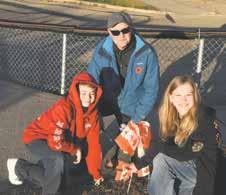
By MooseJawToday.com staff
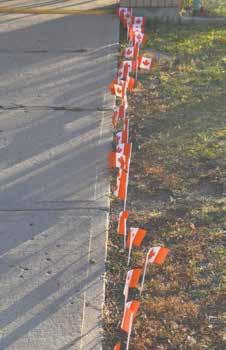
Michelle Lang was previously a reporter for the Times-Herald newspaper in Moose Jaw. On Dec. 30, 2009, Lang was killed in Afghanistan while reporting on the war for Canwest News Service and the Calgary Herald during a six-week assignment.
While most Remembrance Day
services focus on the First and Second World Wars and the Korean War, Sunningdale takes a different approach to its remembrance.
It does this with support from the Friends of the Forces Fellowship, which co-operates with the school’s administration — including principal Dave Osberg and vice-principal Leanne Meili — each year by gathering the flags and installing them at the school with students’ assistance.
The fellowship noted that planting the flags is “a special service for our community.” Those members from the fellowship who helped place flags at the school this year included member Lyle Johnson, chairman Phil Adkins and

vice-chairman Robb Nesbitt.
Students at Sunningdale Elementary School also participate in the yearly Remembrance Day poster contest that the Royal Canadian Legion Branch No. 59 holds.
Furthermore, students help decorate the school in the theme of Remembrance Day, and every grade contributes to the effort each year. Commemorative projects include posters, origami poppies used during the morning’s ceremony, and a few works from past students who have graduated from the school.
The highlight of Sunningdale’s Remembrance Day projects is a doorway displaying pictures of Canadian service members.

Moose Jaw’s militia, the Saskatchewan Dragoons invested a new Honourary Lt.-Col. at a recent ceremony in the D.V. Currie Armoury in Moose Jaw.
The new Honourary Lt.-Col. is Holly Jorstad of Moose Jaw who was invested by Lt.-Col. Gillian Dulle, deputy commander of the 38 Canadian Brigade Group.
The position of Honourary Lt.-Col dates back 2,000 years in British history but has been used in Canada for 100 years
Prime Minister Robert Borden said in the 1920s the position connects the military to the community.
Lt.-Col. Jorstad has been and still is involved in many local community organizations.
She is an honourary “Snowbird” of the 431 aerial demonstration squadron, a board member of the Moose Jaw Family Resources Centre at 15 Wing and as a member of the Flying Framers was appointed queen of that group in the 1990s.
She is also a member of the Friends of the Forces
Ron Walter - For Moose Jaw Express

Fellowship.
Her community organization volunteer work also includes Girl Guides Commissioner and Moose Jaw Chamber of Commerce board of directors.
Jorstad is a licensed marriage commissioner, American ordained minister, and has officiated more than 200 marriages.
Owner and operator of Holly Would Rentals, started18 years ago, she has been involved in over 1,000 functions.
Her husband, the late Cal Jorstad, was Honourary Colonel of the Big 2 flight school at 15 Wing. She was born in Rockglen and grew up on a farm. She moved to Moose Jaw in the 1970s, was married in 1980. The Jorstads had two children, Shelly and Curtis.
She lives on the family farm.
Ron Walter can be reached at ronjoy@sasktel.net
By Joyce Walter - for Moose Jaw Express
The views and opinions expressed in this article are those of the author, and do not necessarily reflect the position of this publication.
A few weeks ago I asked the question: why do builders place cupboards above the spot designed for a refrigerator? It turns out that several readers have the same question.
E-mails, phone calls and in-person discussions ensued with confessions that very few of these individuals could remember what was stored in those mostly-inaccessible cupboards.
One or two said they dragged out a stool and undertook a discovery mission, with one lady noting she had stored a stash of brown paper bags in one of her cupboards, and boxes of chocolates in another. The bags were put in the recycling bin and the chocolates were fed to the garbage can.
THE NEXT PSSD BOARD MEETING IS TUESDAY, DEC 2, 2025
A program that Prairie South School Division launched last year to encourage students to attend school regularly is receiving attention from the provincial government because of how successful the initiative has been.
The division kicked off the “#YourPresenceMatters” campaign in November 2024, with trustees and division administration wearing red T-shirts with the phrase on the front.
The campaign sends a message to students, families and communities that Prairie South cares about its youths and wants them to be in school daily since attendance is good for academic achievement, well-being, and health, administration said at the time.
The board has made regular attendance one of its priorities in its 202428 strategic plan, since trustees believe that if students attend often, the division can educate them, administration said. Moreover, Prairie South is receiving support from River Street Promotions (RSP) since this initiative aligns with the company’s work to support student
I received an e-mail from Lucy who provided an answer to the question.
“They are just there to balance out the lines of the cabinets and keep the line flowing rather than just stopping, which depending on the kitchen, may not look balanced. They frame the fridge . . . but are none the less, useless.
“In saying that, I have seen homes without (the cupboards) and the jury is still out on that. Must be very careful with the layout of cabinets because it can look distorted quite quickly.”
From that explanation, I surmised she was either a carpenter or had some connection to a construction company. I asked and she responded: “I had a brother in the industry. He is older and retired.
He always used a designer for kitchens. Perhaps the younger designers have another take on it now.”
I snooped a bit on real estate listings and figured out that newer homes would be designed by younger designers. Every one of those “newer” homes had those darned cupboards above the fridge. So much for the style of the youngters in the design of kitchen space.
The style was the same in some of the older homes available for sale. Then I looked into an elderly apartment block for sale in the city. The suites inside are currently being remodelled and look upscale. I’m not sure of the age of the contractor, but he/she gets a gold star: the suite I looked at on the computer screen

“does not” have cupboards above the refrigerator.
Thanks to everyone who contributed to the cupboard conversation. Our new fridge is working just fine, thanks for asking, even though the cupboards above continue to be useless. But they do flow from one side to the other in our kitchen space, framing the fridge as they flow!
I just have to remember that if I ever decide to use the bun warmer, Housemate will have to get the ladder and retrieve it for me. Or we could simply get by with cold buns.
Joyce Walter can be reached at ronjoy@ sasktel.net
Jason G. Antonio - MooseJawToday.com
mental health and well-being.
The organization promoted — and continues to promote — the initiative by sending home letters to parents and guardians, using social media, distributing decals and stickers, working with school community councils, communicating in school newsletters, and working with RSP, businesses and other public venues.
Data from an October board report showed that the division’s overall attendance rate for the 2024-25 year was 91.37 per cent, up 0.53 per cent from the year before. In comparison, the provincial average was 79.3 per cent.
Meanwhile, during the November board meeting, data showed that the division had an attendance rate of roughly 95 per cent in September.
Trustee Shawn Davidson said during the meeting that he’s had conversations with the Ministry of Education about Prairie South’s attendance efforts, with ministry officials “taking notice” and asking questions about what the division is doing and why it’s work-
ing so well.
“(The improvement) literally shows up (in the data) provincially compared to other school divisions,” Davidson said.
“It’s just a bit of evidence of what happens when you’re deliberate about something and when you’ve got a great team in our schools (and) across the whole division that take an initiative from this board and run with it and do some really great things … ,” he continued.
If the division can encourage youths to attend, then the “incredible staff” can educate them, Davidson added. Prairie South is “doing a bang-up job” of bringing students to schools; everyone’s presence “really does matter”; and the province has noticed how the division has “moved the needle” in this area.
Ryan Boughen, director of education, said “it was fantastic” and “incredible” that attendance in September was almost 95 per cent. He singled out Derrick Huschi, superintendent of school
operations, for doing great work in supporting high schools with their efforts; principals have offered thanks.
The education director pointed out that Huschi was once the principal at A.E. Peacock Collegiate and did “an incredible job” with managing attendance. So, today, his leadership efforts are paying off — even if he must arise at 5 a.m. to do that work.
Boughen added that the division office has thanked school administrators for the work they’re doing with attendance, since those efforts are significant, “quite impactful” and lead to success.
In an email, the ministry said one of the main targets in the province’s education plan is to improve student attendance, while it appreciates divisions’ efforts to improve this area.
“… divisions exceeding provincial targets help drive real progress and positive outcomes in schools across Saskatchewan, contributing to stronger student engagement, learning and longterm success,” the ministry added.
All schools in Prairie South School Division annually create a learning improvement plan (LIP) that focuses on goals around student academics and well-being that they ensure are measurable and timely.
According to the 2024-25 school and division improvement accountability report, presented during the board’s November meeting, for the academic goal:
• 24 schools focused on reading, a decrease of four compared to 2023-24
• 10 schools focused on writing, the same as in 2023-24
• 16 schools focused on math, an increase of four compared to 2023-24
Some schools had multiple goals, the report said, which is why these numbers don’t add up to the 40 total schools in the division.
Meanwhile, for the student wellbeing goal:
• 13 schools focused on belonging or
Jason G. Antonio - MooseJawToday.com
wellness, a decrease of eight compared to 2023-24
• Seven schools focused on attendance, which is a new category
• Eight schools focused on the Indigenous Education Responsibility Framework (IERF), which helps them reflect, discuss and plan for improvement; this is a new category
• Six schools focused on “other,” such as credit attainment or behaviour, a decrease of two from 2023-24
Most learning improvement plans showed growth during the 2024-25 year, with 37 of 84 LIPs meeting their targeted goal, the report said. This is an increase of six compared to the 2023-24 year.
School staff develop the LIP goals based on school data, while they ensure that the goals align with the Ministry of Education’s provincial education plan, superintendent Derrick Huschi told trustees during the meeting. Before September, the division provides schools
with LIP templates to fill out, while schools review the goals and data from the previous year and create new LIPs for the current year.
Furthermore, schools share the LIP work plans with their school community councils (SCCs) and can update the plans after receiving input, Huschi continued. The division encourages SCC members — especially chairpersons — to attend the planning sessions to help develop the work plans, which some do.
“LIPs are evergreen and are reviewed and adjusted throughout the school year, and the work plans are reviewed with the superintendents four times per year as part of our visits,” he added.
The report noted that schools are supposed to share their LIP goals and results with students, staff, parents and the community a minimum of three times a year.
SCC engagement
Meanwhile, Prairie South held three parent-engagement presentations during the 2024-25 year, which focused on the board’s strategic plan and the “strategic imperative” of student attendance, the report said.
Administration shared information about PSSD’s #YourPresenceMatters
campaign and discussed research supporting the importance of student attendance and how absences negatively affect learning and wellness, the document continued.
A second focus of the presentation discussed research about screen time and social media and how both can negatively affect youths, the report stated. Concepts from the book The Anxious Generation allowed for good discussion among parents about the challenges of raising youths in a world of changing technology.
Some examples of how schools have handled attendance and screen time during the 2024-25 year include:
• Rockglen put a large #YourPresenceMatters sticker on the rink’s ice cleaning machine, allowing spectators and athletes to see a message about how being present in school “is incredibly important”
• Prince Arthur School hosted a parents’ evening to discuss challenges with managing technology, with the police service’s school liaison officer discussing online activities and an advocacy and behaviour consultant discussing the effects of screen time on the brain
Notice is hereby given under The Tax Enforcement Act that unless arrears and costs appearing opposite the land and title number described in the following list are fully paid before January 31, 2026, a tax lien will be registered against the land.
*Full Circulation means every home & paper should have this yer. If you are missing call us @306-694-1322. *Selected Areas means only selected areas were chosen by the business or agency (please call the business).
Dated this 5th day of November 2025
Ashley Chase, CAO
Shawn Davidson wears many hats, because not only is he a rancher, school trustee and president of a provincial educational organization, he is now the vice-president of a national association.
Davidson was named vice-chairman through acclamation during the Canadian School Boards Association’s (CSBA) annual general meeting in Ottawa in early October.
News about Davidson’s appointment — he is also the president of the Saskatchewan School Boards Association (SSBA) — was made public during Prairie South School Division’s November board meeting.
Jason G. Antonio - MooseJawToday.com
their own decisions instead of people in an office in Regina.
“And for reasons that are sometimes unbeknownst to me, the people, the other trustees of the province, and now the country … see something in me and they keep advancing me to other positions, so here I am,” he added.
Davidson has been on the CSBA’s executive for the past three years, since, as SSBA president, he’s automatically appointed to the national board as a voting member from Saskatchewan. He was also on the board from 2016 until 2022.
Continuing, the PSSD trustee said he’s always had an interest in education and representing boards at the national level — he ran for the CSBA president role in 2022 but lost — especially since many elected school boards nationwide are facing challenges.
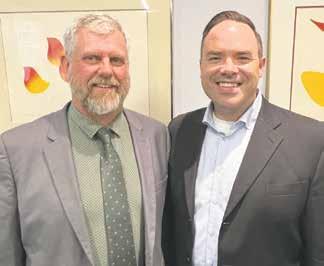
For example, Nova Scotia and Quebec have eliminated their majority-language school boards — English and French, respectively — which has created a twotiered system of representation in education, Davidson said.
ed. Now that he’s the national association president, that issue is something in which he wants more involvement.
The Canadian School Boards Association is an advocacy group that works not only with provincial governments but also with the federal government, as many national topics affect school divisions locally, said Davidson.
For example, the CSBA heavily focuses on First Nations education, since Ottawa funds on-reserve schools, he continued. For years, the association has been advocating for parity in funding between provincial schools and federally funded on-reserve schools.
“And we’re still not quite there,” the trustee stated, pointing out that the feds have cut back funding for additional services for on-reserve students.
Furthermore, the national association focuses on mental health and well-being, which are also core pillars in Saskatchewan’s education plan, said
Davidson. That is important nationally since Ottawa funnels money to the provinces, which pass that funding to school divisions.
Housing is also an advocacy issue, since there are challenges with providing suitable accommodations for teachers who live in northern areas, he continued. Shoring up housing availability is important so educators can teach in isolated and remote communities.
Moreover, broadband internet accessibility in rural and remote communities “is abysmal” in some locations, especially in Saskatchewan, so federal funding is required to help those places, Davidson said. Also, Ottawa must implement policies and regulations around the use of artificial intelligence (AI).
“So, there’s lots of advocacy work that the CSBA does at a national level that provincial organizations really can’t embark upon on their own,” he added.
“Well, it’s another challenge, I guess, another chapter for me in education leadership,” he told MooseJawToday.com.
Davidson said he’s a cattle rancher with great employees — his two stepsons — who help keep the Aneroid-area ranch operating while he’s away. His boys are “fantastic,” and, without them, he wouldn’t be able to take on these roles.
He noted that he is passionate about rural education and keeping 50-student schools operational, while he believes it’s important for rural people to make
This means minority-rights holders can have publicly elected school boards, local choice and a local voice in education, while larger public boards in some provinces do not, he continued. Ontario is considering following the lead of the other two provinces.
“So that’s something that I’m deeply concerned about. I firmly believe in locally elected democracy in education,” the trustee remarked, noting that “it’s vital” that all voices — whether Francophone, English minority, Catholic or public boards — have elected representation.
Ensuring that citizens can vote for community-based trustees is an issue the CSBA wrestles with, Davidson add-

By Joyce Walter - For Moose Jaw Express
Christmas cake baking season is well underway. These cakes, filled with glazed fruit, raisins and nuts cause various reactions in many individuals, from delight to disgust. But traditionally, Christmas cakes are much loved and savoured, baked from treasured recipes that have been handed down through generations of bakers.
Christmas cakes may be frozen to be enjoyed throughout the year. Wrap in several layers of waxed paper and then with a layer of foil.
This week’s recipes offer three styles of Christmas cake.
• • •
DARK FRUIT CAKE
1 lb. butter
2 cups sugar
6 eggs
2 tbsps. molasses
1 cup thick cream
2 tsps. vanilla
1 tsp. rum or brandy
2 tsps. baking powder
1 tsp. each cinnamon and nutmeg
1/2 tsp. cloves
2 tbsps. lemon juice
2 cups flour
2 lbs. raisins
1/2 lb. mixed peel
1 lb. mixed fruit
1 lb. red and green cherries
2 pineapple rings
1/2 lb. blanched almonds, optional Heat oven to 250 degrees F. Dredge fruit
and raisins with 1 cup flour. Line loaf pans with parchment paper and grease.
Cream sugar and butter. Add eggs one at a time and mix after each one. Add lemon juice, molasses, cream and flavouring. Beat well.
Add remaining 2 cups of flour, baking powder and spices.
Add fruit and mix well.
Bake for 3 1/2 to 4 hours or until batter does not cling to a testing stick. For best results, add a pan of water to the oven half way through baking to keep cakes moist.
Cool in pans, then turn out onto racks and cover with towels overnight.
Wrap in waxed paper and then an outer layer of foil and let season for at least three weeks before slicing.
•
3 cups white sugar
2 cups butter
10 eggs
1 cup orange juice, without pulp
5 cups flour
1/2 tsp. salt
2 lbs. golden raisins, washed and dried 2 lbs. red and green cherries, halved
1 lb. blanched almonds and brazil nuts, both rolled finely.
Cream butter and sugar. Add unbeaten eggs, one at a time. Beat after each addition. Measure flour and sift and measure again. Add half alternately with orange juice, dredging
fruit with remaining flour. Add fruit and nuts.
Bake in lined and greased pans for 3-4 hours in a 300 degrees F oven. Place open pan of water in oven for moisture.
Cool slightly in pans, then remove to racks and cool completely. Wrap tightly and store in cold, dark cupboard for several weeks before slicing. If desired, wrap one loaf in cheesecloth that has been immersed in rum. Store separately and add more rum as desired for the storage time. •
1 cup sugar
1 1/4 cups water
1/3 cup butter
1 cup golden raisins
1 tsp. baking soda
1 tsp. baking powder
1 cup mixed candied fruits or cherries
2 cups all-purpose flour
Combine sugar, water, butter and raisins and bring to a boil, boiling for two minutes, stirring continually. Remove from heat and cool.
Combine flour, baking powder, baking soda and fruit. Mix well.
Pour into two greased and paper-lined pans. Bake at 325 degrees F for 1 hour. Cool on racks, wrap and store for a few days before serving.
Joyce Walter can be reached at ronjoy@sasktel. net
Crafters and early Christmas shoppers will fill the Timothy Eaton Centre later this month when the Moose Jaw and District Senior Citizens’ Association hosts its annual craft fair on Saturday, Nov. 22. The fair runs from 9 a.m. to 3 p.m.
Aaron Walker - Moose Jaw Express
at 510 Main Street North, with admission set at $2 per person. The Timothy Eaton Café, located inside the centre, will be open from 8 a.m. to 1 p.m. offering breakfast and refreshments. Everyone is welcome to attend.
The centre is home to the Moose Jaw and District Senior Citizens’ Association and Age-Friendly Moose Jaw. For more information, call 306-694-4223 or email MJSenior@shaw.ca.
The Moose Jaw Kinsmen Speed Skating Club will host a rib night fundraiser on Monday, Nov. 24, from 4:30 to 8 p.m. at the Crushed Can Rec Room and Bar.
Aaron Walker - Moose Jaw Express
Tickets are $25 per person and available for purchase at the door. The evening includes a half rack of ribs, with proceeds supporting club programming, coaching, and equipment needs for the upcoming season.
The club offers recreational and competitive programs for all ages, with certified coaches and equipment rentals available. Practices are held at Kinsmen Arena throughout the week from October to March.
For more information, visit MJSpeedSkating. com or email MJSpeedSkating@gmail.com. The Crushed Can Rec Room and Bar is located at 82 Manitoba Street West.
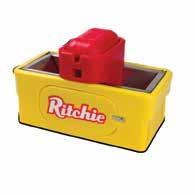
Residents’ continued generosity, plus a record number of volunteers, made this year’s Better Together Food Drive another success, even though the event competed with the World Series and faced rising grocery costs.
The 20th annual event saw 630 volunteers zipping from house to house picking up bags of food while dodging candy-collecting ghosts and goblins. Those bags amounted to 20,744.6 kilograms (46,099 pounds), or 46 pallets that were delivered to the Moose Jaw and District Food Bank. People also donated over $13,000.
Since 2006, the food drive has collected over 402,750 kilograms (895,000 pounds) of food and more than $125,000.
“I was pleasantly surprised (with the results). I actually thought that with the state of our economy and rising cost of everything … that we might not see as great a response from our community,” Jason Moore, the food bank’s executive director, said recently. “But, I was wrong.”
The food bank’s new venue can hold 50 pallets, so it’s “bursting at the seams,” but that number will decline quickly as food is sorted and given out, he stated.
The amount collected was “a godsend,” and even with the community struggling financially, people put aside their interests to care for others, Moore continued. He thought that having helpful neighbours was “one of the greatest blessings” of living here.
Moore celebrated the record number of volunteers who helped, which happened for the second-straight year. He was also thankful that people were willing to give their time, even though it was Halloween and Game 6 of the World Series was happening.
Karen MacNaughton, a co-organiz-

er at Hillcrest Church, said she was “super happy” with the results, while she was “blown away” by residents’ generosity, sponsors’ support and volunteers’ contributions.
She singled out the Exhibition Company for donating the convention centre space and the 120 Grade 9 students from Vanier Collegiate who set up the hall in 25 minutes. She also noted that having over 400 people on the streets collecting made the night go quickly and smoothly.
“It was just an amazing and successful thing … ,” MacNaughton continued, pointing out that this event succeeds because residents know the good it does and the fact that Moose Jaw is small enough for this fundraiser to work.
MacNaughton added that a small team hit the streets on Nov. 1 to pick up outstanding bags of food.
The food bank appreciates residents’ continued generosity, especially since the organization’s client numbers have increased significantly, said Moore.
Four years ago, the non-profit supported roughly 400 people per month, but this past September, 993 people walked through the doors — an increase
of almost 150 per cent. Meanwhile, almost two-thirds of clients are children; the organization served 785 kids in October.
These people are not who one would expect, as they are college students, seniors on fixed income, new immigrants and working families, Moore said. Some seniors are coming to the food bank malnourished because they lack access to healthy food.
The food bank has been attempting to determine how to solve that problem, considering there should not be people starving in Canada, he said. It also “breaks (his) heart” that seniors are in that position.
Furthermore, new immigrants likely never expected to use the food bank, especially since some have come from countries where accessing food was a struggle, said Moore. Meanwhile, “the biggest shocker” is working families requiring help, as people’s wages aren’t enough to pay the bills and purchase food.
The executive director said it was tough to accept that children comprise two-thirds of all clients. While it feels good to help people, he noted that the food bank provides clients with food for

Having received 46 pallets in two truckloads, food bank volunteers are now sorting the items for Harvest Pantry’s shelves, said Moore. This will allow clients to access food they desperately need.
Moore added that he looked forward to the Co-op’s Good Buy to Hunger Campaign, which kicks off in mid-November and runs until early December; it typically brings in 20,000 pounds of food.
The food bank requires volunteer help, with shifts occurring from 9 a.m. to noon and 12:30 to 3:30 p.m. on Monday to Friday and 4 to 7 p.m. on Wednesdays. To volunteer, call co-ordinator Terri Smith at 306-692-3853.
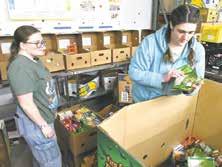

The Government of Saskatchewan announced an $836,000 investment to strengthen policing and public safety in Moose Jaw through the Municipal Police Grants program.
The funding, revealed during a Nov. 7 news conference at Moose Jaw Police Service headquarters, will support two positions with the Police and Crisis Team (PACT) and four positions with the Combined Traffic Services Saskatchewan (CTSS) unit.
Corrections, Policing and Public Safety Minister Tim McLeod said the funding continues the province’s commitment to ensuring communities have the resources to respond to local needs.
“The Municipal Police Grants program provides stable, consistent funding to municipalities, allowing police services to focus on targeted initiatives that improve public safety in our communities,” McLeod said. “City councils and municipal police services are best equipped to know what public safety concerns are affecting their own communities.”
Aaron Walker - Moose Jaw

This year, the province, working in partnership with Saskatchewan Government Insurance (SGI), is investing $22.3 million to support 160 municipal police positions in nine municipalities across Saskatchewan. Two of the CTSS positions are funded directly by SGI at a cost of $360,000.
Since 2017, the City of Moose Jaw has received about $6.6 million through the program, which has distributed more than $300 million to municipalities across the province since 2007, according to McLeod.
Rural Municipality of Maple Bush No. 224
PROVINCE OF SASKATCHEWAN
Notice is hereby given under The Tax Enforcement Act that unless the arrears and costs appearing opposite the land and title number described in the following list are fully paid before the 14th day of January, 2026, an interest based on a tax lien will be registered against the land.
Note:
A sum for costs in an amount required by subsection 4(3) of The Tax Enforcement Act is included in the amount shown against each parcel.
Moose Jaw Mayor James Murdock said the continued funding shows the province’s confidence in the city’s policing initiatives and the people behind them.
“On behalf of the City of Moose Jaw and the Moose Jaw Board of Police Commissioners, I want to express our sincere appreciation to the Government of Saskatchewan and SGI for their continued investment in public safety,” Murdock said.
He highlighted PACT and CTSS as “essential roles in building a safer, stronger Moose Jaw.”
active force in preventing collisions and saving lives on Saskatchewan’s roads.
“Every patrol and every traffic stop contributes to making our roads safer for everyone who calls Moose Jaw home,” he said. “These initiatives reflect the kind of community we strive to be: one that looks out for one another, values safety, and works together to solve challenges with care and commitment.”
Moose Jaw Police Service Chief Robert Davis echoed that message.
“These investments are more than just numbers on a page — they represent real capacity with real people making a real impact on the front lines of public safety,” Davis said. “The PACT team is one of the most meaningful initiatives we have. Every day, our officers respond to complex situations involving individuals in crisis — people who are struggling (with) mental health challenges, substance abuse, or trauma. Through PACT, our officers work side by side with mental health professionals to provide the right response at the right time.
“In the short time I’ve been here, when I’m walking around the community and talking to citizens, all the time PACT comes up, (and residents talk about) what an impressive job the unit’s doing and the great work that they do to extend care into the community,” he continued. “This approach reduces repeat calls, lowers the risk for everyone involved, and helps build trust between the community and the police. It’s a program that reflects how policing has evolved and continues to evolve towards compassion, collaboration, and community-based solutions.”
He called both PACT and CTSS “critical pieces of public safety.”
TOTAL
Dated this 6th day of November, 2025
JoAnne L. Wandler Administrator
“PACT is a shining example of compassion and collaboration in action,” Murdock said. “This team pairs police officers with mental health professionals to respond when someone is experiencing a crisis. It ensures that people in distress are met not only with protection, but with care, connecting them to the support and resources they truly need.”
Murdock added that the CTSS team is “equally vital,” describing it as a pro-
“Every officer in CTSS understands that, behind every traffic stop, (there) is the potential to save a life,” Davis said. “Road safety isn’t just about enforcing laws; it’s about ensuring that everyone who leaves home makes it back. … Through these two initiatives, we’re not only enforcing the law, we’re (also) building a safer community which is safe for everyone to call home.”
For more information, visit Saskatchewan.ca.
The Rural Municipality of Moose Jaw will soon discuss city hall’s request for permission to annex 384 hectares (960 acres) of prime farmland near Highway 2 north for a new landfill.
City hall recently ran advertisements in two editions of the Moose Jaw Express newspaper about its intention to alter the city’s boundaries by annexing one of two locations on the east and west sides of Highway 2. Both locations each total 6.25 sections of land, or 960 acres.
It also sent a letter to the RM office asking for comments about the proposal.
The deadline for the rural organization — and any other interested parties — to comment on the plan is Wednesday, Nov. 19, by 5 p.m.
Mike Wirges, the RM’s administrator, said it is “no surprise” that the City of Moose Jaw wants to annex this land. However, the rural council
Jason G. Antonio - MooseJawToday.com
has made its urban counterpart aware that it’s “not interested” since the project would eliminate “prime farmland.” Instead, the RM — plus other area municipalities — wants a regional solid waste management venue constructed.
“But it’s obvious from the city’s time constraints, they certainly want to push forward with this,” he said.
The RM has informally discussed the matter and is “quite adamant” against it, but has not produced an official resolution saying “no,” Wirges continued. Council will have an in-depth discussion during its Nov. 12 meeting, where it will likely produce a formal motion saying it’s against the annexation plan.
Moose Jaw council made it known that it requires only one of the two sites, along with 156.09 hectares (390.23 acres) for the solid waste venue, “but for some reason,” it wants both sites, said Wirges.

The city “can” unilaterally annex the land, but the provincial government has a process that municipalities must follow, the administrator pointed out. Since there’s likely to be “backlash” from people, the city will have to hold a public meeting to hear their concerns.
Furthermore, the RM must respond within 30 days of the city’s notice, and if the organization either doesn’t respond or says no, then city hall can go to the Saskatchewan Municipal Board (SMB) for
a ruling, Wirges said. The SMB could appoint an arbitrator to negotiate between the parties.
However, he pointed out that the RM hadn’t yet “crossed that bridge.”
“We want to be listened to and search for other alternatives,” Wirges stated, pointing back to a centrally located regional landfill.
He added that since Regina’s landfill will close in 25 years, a regional venue could support smaller communities that have closed their landfills and are hauling their garbage elsewhere.
In an email, the city said that, using detailed studies from qualified consultants, it identified several locations for a new solid waste facility (SWF). Furthermore, “given the time constraint” to build a new SWF — the province wants the current dump decommissioned in 36 to 48 months — the city is attempting to ensure that at least one location is successfully secured.
“The city can pull back from either of these locations at any time if one location emerges as favourable,” the email stated, noting that the city does not require 960 acres, while the SWF requires “at least” 320 acres.
Continuing, the city said it “is always concerned about consuming agricultural land and only annexes land when it is required,” and in this case, a new venue is required.
The email noted that the city is investigating options in the southeast near the lagoons, but those areas do not permit such developments because of proximity to 15 Wing Airbase, “hence the need to annex land.”
Meanwhile, the city pointed out that the RM is aware of its approach to acquiring land and raised the idea recently of a regional landfill, the email said. However, given the current landfill’s lifespan, the city must
continue advancing its plans to ensure that waste management services are not disrupted.
“We remain open to future discussions about regional solutions where they are practical and timely,” the email said.
The city added that a July
city council report reviewed the potential for solid waste management alternatives — such as waste-to-energy technology — and determined that such technology presented “inherent sustainability challenges.”
Moose Jaw Board of Police Commissioners
The City of Moose Jaw is inviting applications for citizenat-large members to serve on the Board of Police Commissioners. This is a vital opportunity to contribute to public safety and community oversight.
We are seeking individuals who demonstrate high ethical standards, integrity, and a commitment to public service. Ideal candidates will possess:
• Understanding of police governance and strategic policy-setting roles
• Experience in budget planning, financial oversight, or fiscal governance
• Proven leadership and collaboration skills
• Respect for diverse perspectives and knowledge of Indigenous and community dynamics
• Capacity to address complex issues with resilience and enthusiasm
• Willingness to meet weekday time commitments for monthly meetings
Eligibility: Must be a Canadian citizen, 18+, and a resident of Moose Jaw. City employees and contractors are not eligible.
Required: Resume, cover letter, current criminal record check, and two reference letters.
Deadline for Applications: Friday, November 14, 2025
Submit applications to: City Clerk’s Office, 228 Main St. N., Moose Jaw, SK S6H 3J8 or email cclerk@moosejaw.ca.
Apply now on the Board of Police Commissioners page at www.moosejaw.ca and help shape the future of policing in Moose Jaw!
A quiet stillness settled over the gym at Sunningdale Elementary School on the morning of Nov. 6 as students, staff, and families gathered for the school’s annual Remembrance Day ceremony, a tradition that continues with each passing year.
Sunningdale’s yearly tradition began in the early 2000s after a former student’s parent was killed while serving with the Canadian Armed Forces in Afghanistan. Since then, the school has partnered with the Friends of the Forces Fellowship to help students better understand the significance of the day. Students walked from their classrooms past rows of poppies, thoughtfully crafted posters, and the familiar colours of remembrance that lined the hallways as they joined cadets and guest presenters in quiet reflection.
The ceremony featured student presenters, a selection of music, and a moment of silence. While some messages may not immediately resonate with younger grades, older students said the yearly practice builds awareness. For some, the ceremony carried a deeper, personal connection.
“I had grandfather in the military,” Grade 8 student Aspen said, followed by classmate Alivia, who said, “I had two great-grandfathers in the military … in World War II” and Grade 8 student Belle, who added “I had a great-grandpa and great-grandma … (who served in) World War II.”
For those students without any direct ties to military service, the ceremony provided perspective on a sacrifice they may never know firsthand, but can still understand in meaningful ways.
“I just think it’s very important that all of our younger kids understand how important this is to a lot of people,” said Evan, a Grade 8 student at the school. “It’s very important that we’re not just remembering them on one (set) day, but that we’re remembering them throughout the whole year.”











“I think (their sacrifices) really helped our country (be) safer and freer, and that’s a really important thing,” Alivia said. “It’s really good to remember that people did that for us.”
Emily, a fellow Grade 8 student, added “They were very brave fighting for our country and our safety.”
Many students also spent the past week preparing entries for the Royal Canadian Legion’s poster and poem contest or participating in classroom readings.
“There are some optional contests that you can win prizes for,” Evan noted. “You can make a poster or write a poem, and some classes have readings and (additional projects) as well.”
Beyond the posters and poems, students said the experience is really about the reflection and understanding gained through creating them.
“I just think it’s really cool that we do this,” Emily said. “Every year, the whole school comes (together) … It’s a good way to remember.”
As the gym returned to its everyday rhythm and chairs were
put back in storage, the meaning lingered in conversations, in artwork, and in the quiet understanding that remembrance extends beyond any single morning.
“I think you have to remember that, even if it’s (observed on) one day and then the day is over … these people served (and some lost) their lives just to (allow us to) have a better one,” Aspen said. “We have to remember that.”



Jason G. Antonio - MooseJawToday.com
A telephone’s shrill ring at 5 a.m. on Feb. 24, 2022, surprised Snizhana Fomychova, as the voice of a military friend told her to leave Ukraine because war had begun.
The woman was already awake, as she was preparing tea for her ill husband, Artur Levytskyi, and feeding their baby.
“At first, we didn’t believe him (because) it sounded unreal. But just a few minutes later, we heard the first explosions,” Fomychova said recently during a presentation at the Moose Jaw Museum and Art Gallery.
The couple, who had lived on the Crimean Peninsula for several years, had moved to Kyiv a week earlier because they wanted their children to learn the Ukrainian language. That wasn’t possible on the peninsula because Russia had occupied it since 2014.
Now, with explosions rocking the Ukrainian capital, Fomychova, Levytskyi, and their four children stayed inside their apartment, leaving only for food, she recalled. They did not shower or change their clothes for three days, while they sometimes lived in the basement.
However, most nights, they slept in the hallway because that provided enough protection from missiles, Fomychova continued. However, she had finally had enough and told her husband that they needed to leave; he agreed to go.
The family arrived at the train station, which was “a zoo” because everyone was fleeing as well, said Fomychova. The family waited 11 hours before they acquired a spot on the train. After finding seats, all four children immediately fell asleep, but not Fomychova.
“The adrenaline didn’t let me rest,” she recalled.
After reaching the home of Levytskyi’s parents — his parents decided to remain — the family found strangers to drive them to the Polish border. Fomychova recalled heading toward Poland and encountering traffic jams 100 kilometres long. They eventually reached a border town and stayed with her father’s friends before boarding a bus and entering the country.
Red Cross volunteers offered plenty

Artur Levytskyi, Snizhana Fomychova and their three-year-old daughter at the Moose Jaw Museum and Art Gallery theatre, after a presentation about their flight from Ukraine.
of support, with one person giving them first-class train tickets to Gdansk, she said. The family travelled to the Baltic Sea city, where someone offered them a rustic home for several years until they started a new life.
“We had only about $3,000 left, so it was a big help,” Fomychova remarked.
One day, Fomychova received an email from a Canadian suggesting she move to Quebec. Even though the remote community was small and required either a helicopter or a snowmobile to access, the family accepted the offer.
An airline provided the family with free tickets since they were refugees.
“We had almost no money, but we had big hopes,” Fomychova said.
The family flew from Gdansk to Paris, France, where Fomychova lost a backpack filled with family jewelry, valuable coins and other heirlooms. They then flew to Montreal, where their sponsor met them and provided them with paperwork to live in Canada.
They then began a multi-aircraft journey that took them over sparsely populated land, until, by helicopter, they arrived in the 100-person village of Tête-à-la-Baleine on Quebec’s east coast; the school had six children.
“When we arrived, people welcomed us with great kindness,” said Fomychova, noting residents provided the family with food — including seal meat — and clothing.
Meanwhile, since not all their luggage fit in the helicopter, their sponsor offered to bring their possessions by snowmobile and sled across frozen lakes and through forests. The family thought that was how Canadians did things and didn’t question his actions.
However, Fomychova learned that that was the man’s first long-distance snowmobile trip, while he had only lived in the village for a few years. During his journey, the temperature plummeted to minus-30 Celsius, and his machine broke down. After failing to fix it, he found a cabin and remained there until help arrived.
Life in the village was difficult as there were no jobs. Yet, the family received attention from reporters because they were only the second group of Ukrainian refugees in the region.
Later, Fomychova and Levytskyi moved to a bigger village that had jobs, fresh food, was closer to cities — like Montreal — and had better living accommodations. At Christmas, the village decorated a tree “that really looked like something from a movie; so beautiful and full of love.”
While the family loved the new village, they grew tired of the clouds of black flies, while Levytskyi wanted a new job. So, Fomychova began searching online and connected with Moose Jaw’s Christy Schweiger, who ran a Facebook page dedicated to helping Ukrainians.
Levytskyi arrived first in Moose Jaw and lived with an English teacher who helped Ukrainian refugees; Levytskyi found a job two weeks after

Snizhana Fomychova holds up a vinyl record she decorated for a fundraiser and an artwork that she has created. She created the latter piece through her new business, “Spirit of Moss Eco Décor Studio.”
he arrived, while Fomychova and the four girls came soon after.
“We were so inspired by this new chapter. Even going to a big store like Superstore felt magical,” said Fomychova, noting that the province’s Ukrainian heritage also attracted them to Saskatchewan. “After living in tiny villages, it felt like a dream.”
Since arriving in Moose Jaw, the family has explored the community and travelled across Canada; Fomychova has started a business called “Spirit of Moss Eco Décor Studio.” They also hope to become permanent residents and support other Ukrainian refugees.
For more information, visit spiritofmoss.ca or mjmag.ca.
This November, the Western Development Museum (WDM) invites visitors to pause and remember through Remembrance Day-themed activities and gallery explorations, as the museum takes a break to prepare for the return of “A Christmas Long Ago” in early December.
Upcoming events
• Treaty Timeline: Until Jan. 3, 2026, museum guests are invited to learn about Treaty history in Canada by walking along a life-size timeline display. The Treaty Timeline was made in partnership with the Office of the Treaty Commissioner.
• A Christmas Long Ago: The event returns to the WDM Moose Jaw on Dec. 6 and 7, offering families a chance to step back into 1910 settler life and explore the holiday traditions of generations past. Visitors can learn about early Christmas customs, see the types of gifts children once received, play with wooden toys, and make an old-fashioned craft before exploring the galleries. The program will run at 10 a.m. and again at 2 p.m. on both days.
Seek and find
The museum regularly holds seek and find events to encourage interactive learning. The program includes an activity sheet, and visitors search the galleries for clues on interpretive signs or display cases. Check the museum’s website for updates.
• Poppy seek and find: Visitors are invited to honour Remembrance Day by searching for 10 hidden poppies throughout the museum’s galleries, noting each location on a provided seek and find sheet. The event offers a

• Wheels way up close seek and find: Explore the museum’s collection up close by identifying classic artifact wheels from a series of zoomed-in photos hidden throughout the galleries. Write down the correct artifact names on the seek and find sheet, then submit your results to finish the challenge. The event will continue throughout November.
Courses and workshops
The museum offers seasonal educational courses that teach skills ranging from blacksmithing to steam traction-engine operation, with certificates typically awarded upon completion.
• Upcoming courses: Contact the museum’s program and volunteer co-

To showcase the raw power of steam energy, the WDM showcases its fully operational K+S Potash Canada Short Line 101 steam train each summer, and guests can catch a ride on a working piece of Saskatchewan’s history. Operating since 1978, this is Saskatchewan’s only operational steam locomotive.
• Upcoming train schedule: The Short Line 101 has officially concluded its season.
Reminiscence Kits
The museum’s Reminiscence Kits are meant to bring generations together and ignite new friendships through the sharing of memories. These kits, containing everyday artifacts from the 1950s to the 1970s, can be rented by care homes and other organizations for two weeks at a cost of $75, with an additional $25 fee for a one-week extension. Visit WDM.ca/Reminiscence to book your kit.
Teacher resources
Teachers can access a variety of resources, including information packages and field trip arrangements at the WDM. Visit WDM.ca/MooseJaw/Learn/For-Teachers for more information.
• Educational programs: The WDM features several educational opportunities open for booking this school year, including dozens of in-
person programs that make an ideal field trip and virtual learning options. For more information, visit WDM.ca.
• Win a free field trip: Educators and community leaders are invited to enter online at WDM.ca/FieldTripGiveaway for a chance to win one of four field trips, plus $200 to cover the cost of transportation this school year. The contest runs until Jan. 4, 2026, with winners drawn on Jan. 7, 2026.
The museum’s history album tells Saskatchewan’s story through the experiences of families, small towns, and community organizations across the province. To view the album, visit SaskHistory.ca.
The museum may just be the perfect venue for your child’s upcoming birthday party. Children ages five to eight can enjoy a two-hour transportation-themed party with up to seven friends included in the $200 fee. You can book by calling the museum at 306-693-5989.
The WDM is always looking for volunteers to help make programming, summer events, and numerous specialized roles at the museum possible. During regular volunteer intakes, the museum’s volunteer co-ordinator will give a facility tour, review safety protocols, and match opportunities to volunteers’ skills and interests.
• Next volunteer orientations: Contact the museum’s program and volunteer co-ordinator at 306-693-5989 for more information.
The WDM is the largest human history museum in Saskatchewan and features a collection of over 75,000 artifacts across four locations. The Moose Jaw branch specializes in the history of transportation.
The museum is currently open daily from 9 a.m. to 5 p.m., with closures on statutory holidays until Easter 2026. From January to March 2026, the museum will also be closed on Mondays until summer hours resume. For more information, visit WDM.ca/ Moose-Jaw or reach out to the museum’s program and volunteer co-ordinator at 306-693-5989.
The Western Development Museum in Moose Jaw is located at 50 Diefenbaker Drive.
A Moose Jaw film director’s inaugural project — about a priest walking into a bar and encountering a struggling drinker — is receiving international attention and accolades since its world premiere in New York City.
“A Priest Walks Into A Bar,” a seven-minute short film written and directed by Timothy Lenko, hit the big screen in The Big Apple on Oct. 12 during the Soho International Film Festival.
Since then, it has been nominated in four other festivals, while on Nov. 4, it was named the Best International Short Film at the Golden Lion International Film Festival (GLIFF) in Kolkata, India.
Meanwhile, the Canadian premiere occurs on Thursday, Nov. 27, at 7 p.m. at the Mae Wilson Theatre, with a Q&A with the cast and crew and an artists’ panel. The second showing is on Sunday, Nov. 30, at 3:30 p.m. in the library theatre.
Lenko said he found it rewarding to make something like this, while he was “so grateful” for everything that’s happened since the film’s release. He was particularly thrilled about the premiere in New York City — he hyperventilated beforehand and was on cloud 9 afterward — while it was gratifying to receive the GLIFF award and other nominations.


after.
While Lenko has directed commercials, this was his first time leading a narrative film, an experience he loved. He said he’s always been interested in the film and television industry, so he was thrilled to assemble a team and create something from his imagination.
Continuing, Lenko said he purposely chose a small project to serve as an initial learning experience. That is why the short is seven minutes long, was filmed in one location — Bobby’s Place — and was shot in one day. These factors ensured the project wouldn’t be “super risky” or expensive.
“… I’m fortunate enough to know a lot of incredible Saskatchewan film artists … ,” he added. “So, it did turn out really, really well on that front.”
Jeremy Ratzlaff, a well-known Moose Jaw film director and cinematographer, was the project’s director of photography.
venue with a great projector and sound system.
The artists’ panel on Nov. 27 will feature a discussion about incorporating religious themes in art that doesn’t devolve into “propaganda,” he continued.
“I think there’s a time and place for didactic statements, but I’d prefer when art isn’t black and white,” Lenko stated. “It’s more of a playful exploration of what life is. And I think there’s a lot of humour and other stuff worth seeing in the mess between the lines.”
Lenko pointed out that many films, books and artworks explore religion from two perspectives: as a “hardcore pro” evangelistic tract or an anti-religion “church take-down piece.” He’s not interested in either approach, and instead, wanted to focus on how messy life is and where “light and grace” are in those situations.
For more information, visit www. timothylenko.com.
“I’m really enjoying that sense of connection to other people because that’s a huge part of why I love to make art,” Lenko said. “I’m making it not just for me, but also to inspire and entertain and encourage other people.”
The director said the film’s plot is “almost painfully self-evident”: a priest walks into a bar and chats with a man — struggling with life’s issues — drinking alone. The encounter leads to a mistaken identity and an unexpected outcome.
Lenko noted that naming the film after a joke set-up was “a happy accident.” His script, which he wrote last year, started as a creative experiment since he wanted to make a film with a joke-like structure: set-up, escalation and punchline. The film’s name came




Lenko — a co-writer on Ratzlaff’s 2023 film “Fear and Trembling” — thought having the experienced professional’s support “was so special” since he has a good eye for filming a scene, frames a shot well and lights a scene well.
The first-time director also expressed admiration for Ratzlaff’s character, saying the latter has a “genuine heart,” is generous in helping new artists and enjoys celebrating Saskatchewan’s film industry.
Moose Jaw is the perfect location for the film’s Canadian premiere, since it was filmed here and had support from business owners, Lenko said. Moreover, the Mae Wilson Theatre is a “beautiful”





Warriors score three in power play, go on to 6-5 victory in WHL action
The Warriors roared out to a 4-0 lead and responded to every comeback push they saw from the Blades the rest of the way -- including a wild eight-goal second period -- before taking a 6-5 victory at SaskTel Centre in Saskatoon.
Moose Jaw improves to 9-8-1-0 and remain in sixth place, three points back of Saskatoon, who fall to 10-7-2-0.
Saskatoon had the early control and held the Warriors without a shot in the first four minutes, but Moose Jaw’s first power play of the game would change all that.
Warriors captain Lynden Lakovic would win a battle along the boards and get the puck out to Casey Brown, who’d find Aiden Ziprick in the high slot with a one-timer pass for the game’s opening goal with 4:13 gone.
The remainder of the period was mostly a backand-forth affair, with neither team receiving much by way of steady zone control, but the Warriors would have a good scoring chance late in the first. Gage Nagel went in on a breakaway with 2:50 remaining and tried a backhand-forehand move before Blades goaltender Evan Gardner came up with the big pad save.
The Warriors had a chance to extend their lead late in the period when Saskatoon’s Cooper Wiliams was hit with a double-minor slew footing penalty, and they struck quickly on the first minor. Lakovic scored his WHL-leading 15th of the season, ripping a perfect shot from the top of the right faceoff dot top shelf glove side for the 2-0 lead with five seconds left in the first.
The second power play continued to start the second period, and the Warriors would strike again for their third goal in as many man-advantage opportunities. Pavel McKenzie picked the puck off the left

Randall Palmer - MooseJawToday,com

boards and would work his way into the corner before finding Riley Thorpe in the slot, and Thorpe’s quick shot would make it a 3-0 game only 1:21 into the second. It was a milestone assist for McKenzie, giving the overage forward 100 points on his career.
That was the end of the night for Gardner, who allowed three goals on 11 shots in 21:21 of work.
It didn’t take long for the Warriors to get to replacement Ethan McCallum, as only 40 seconds after he took over in the Blades goal, Jan Trefny would make it a four-goal game. Brady Ness got off a shot from the point and Trefny would outduel a Blades defender in front of the net to tip the puck home.
Saskatoon would get things going not long after, beginning with their first power play of the game mo-
ments after Moose Jaw’s fourth goal.
Cooper Williams got his stick on a point shot by David Lewandoski and tipped it past Warriors goaltender Kyle Jones with four minutes gone in the frame, and Hunter Laing would put home a rebound off a shot by Brayden Klimpke three minutes later to make it a 4-2 contest with 7:12 gone.
The Warriors would get one back 44 seconds later when Lajoie hit Thorpe with a precision pass to the front of the net, and he’d tip the puck top shelf to restore their three-goal lead with eight minutes remaining.
Moose Jaw product Rowan Calvert appeared to have pulled Saskatoon back within one two minutes after that goal, but a quick review showed that a shot that appeared to go off the back bar of the net instead hit the crossbar and post before bouncing out.
The Blades kept up the pressure as the period progressed and they were rewarded with two more quick goals to make it a one-goal game.
Williams first scored on a partial two-on-none shorthanded breakaway with Tyler Parr with eight minutes remaining, and 1:51 of that marker, Jordan Martin would make it 5-4 after putting home a redirection off a Parr point shot.
The offence wasn’t done there, as Lakovic would continue his impressive outing with his second goal and fourth point of the game, breaking into the Blades zone and ripping a shot low glove side with 1:02 remaining in the period.

The Warriors are back in action on Saturday when they host the Regina Pats, with a special matinee puck drop set for 2:30 p.m at Temple Gardens Centre. Saskatoon also plays Saturday, taking on the Calgary Hitmen at 7 p.m.






Caden Brown has two goals, five points as Regina goes on to 6-3 win in Moose Jaw
The Regina Pat Canadians won the battle of the power plays on Saturday afternoon against the Moose Jaw Warriors, and that turned into a victory for the visitors in Western Hockey League action.
Randy Palmer - MooseJawToday.com
Regina scored twice with the man advantage in the third period and scored three times on the power play overall as they’d take a 6-3 victory at Temple Gardens Centre in Moose Jaw.
Conference, while the Warriors fall back to .500 at 9-9-1-0 and remain in sixth, two points up on Regina.
The Pats improve to 7-9-1-1 and jump into seventh place in the Eastern
The Warriors couldn’t have asked for a better start, carrying the play from the opening face-off and generating a ton
of chances in the Regina zone. They’d record eight shots in the first eight minutes while holding the Pats without a shot in the same span, but Regina goaltender Schlenker would make a handful of big saves to keep things scoreless.
Warriors take 3-2 victory in tight-checking battle to finish off busy slate of games
The Moose Jaw Warriors turned in a solid defensive performance and had a handful of big saves from former Rebels goaltender Chase Wutzke on their way to taking a 3-2 overtime victory at Temple Gardens Centre in Moose Jaw.
Ethan Semeniuk was the overtime hero, scoring on a breakaway with 2:25 remaining in the extra period..
Moose Jaw improves to 10-9-1-0 and pull within a single point of the fifthplace Saskatoon Blades, while Red Deer drops to 6-10-1-2 and are 10th overall in the Eastern Conference.
It’s safe to say the Rebels got off to a quick start in this one. Only 43 seconds into the contest, Nate Yellowaga got off a shot from the point and Samuel Drancak was into the right spot in front of the net to get the deflection for the game’s opening goal.
The Warriors had a great chance to take the lead with three minutes gone in the period when Landen McFadden

Randy Palmer - MooseJawToday.com
and Lynden Lakovic went in on a twoon-one, but Rebels goaltender Matthew Kondro would make an outstanding cross-crease save on Lakovic to preserve the one-goal edge.
The Warriors received their second power play of the game with 9:35 remaining in the first, and Lakovic would tie things up. The WHL goals leader finished off some decent puck movement in the Red Deer zone by putting home a shot from the right face-off circle for his 17th of the season. The goal came with 7:57 remaining in the frame.
That’s where things would stand until early in the second period when the Warriors would get a shorthanded marker.
Aiden Ziprick hit Gage Nagel with a long breakout pass, and he’d go in on a two-on-none with Casey Brown, resulting in Brown putting home a crosscrease pass with 2:58 gone in the period.
Neither team would hit the

Warriors forward Casey Brown finishes off a two-on-none shorthanded chance with Moose Jaw’s second goal of the game.
scoresheet until late in the period, in no small part thanks to the play of Kondo and Warriors goaltender Chase Wutzke, each of whom came up with a handful of big saves.
Red Deer would put their power play to work with five minutes remaining in the frame, and they’d tie the game.
Jaxon Fuder got off a shot from the left
face-off circle that would sneak past Wutzke short side with 3:41 remaining in the second.
Each team would have a handful of chances to break the deadlock in the third period, but both goaltenders would hold the fort, and things were off to overtime.
That’s where Semeniuk would end it. Rebels defenceman Justin McInnis lost his footing crossing the blue line, and the Warriors overager would scoop up the puck before finishing off a clearcut breakaway by lifting a backhand over a sprawling Kondo.
Wutzke ended up making 34 saves against his old club to earn the win, while Kondo capped his night with 31 stops.
The Warriors are next in action on Friday night when they travel to Swift Current to face the Broncos. Puck drop is 7 p.m. at the InnovationPlex.

Following the Ontario Open, Moose Jaw judoka returned from the Manitoba Open in Winnipeg earlier this month with a slate of podium finishes, capping a two-day, national-level judo tournament that drew competitors from across the Prairies and added valuable points toward provincial and national rankings.
From the Moose Jaw Koseikan Judo Club, Aayla Lee-Neuman led the way with gold in the U14 −36 kg division, finishing undefeated. The club added three bronze medals thanks to Diedra Halvorson (U16 +70 kg), Oleksandr Kornat (U16 −73 kg), and Emmett LeeNeuman (U18 −66 kg). Kornat, Emmett
Aaron Walker - Moose Jaw Express
Lee-Neuman, and Aayla Lee-Neuman also picked up additional fourth- to sixth-place finishes in higher age or skill divisions.
Local athletes from Control Jiu Jitsu added to the medal haul, led by Hawkins Jacobson, who captured gold in Ne Waza −81 kg and silver in U18 −73 kg. Paxton Nelson added another gold in U21 −66 kg, while Payton Pinel earned silver in U14 −44 kg. Both Nelson and Jacobson also placed fifth in their senior advanced divisions.
In total, Moose Jaw’s athletes returned with three gold, two silver, and three bronze medals, contributing to
Aaron Walker - Moose Jaw Express
SNAPSHOT:
Moose Jaw Warriors forward

Pavel McKenzie joined the ranks of Saskatchewan’s elite on Nov. 7, notching an assist against the Saskatoon Blades to reach the 100-point milestone in his WHL career. The Warriors edged out the Blades 6-5 in a thrilling match in Saskatoon, adding another highlight to McKenzie’s growing résumé. His achievement comes as a new study ranked Saskatchewan’s 306 area code among North America’s top three producers of NHL talent — a fitting backdrop for a province where hockey skill and determination continue to shine through players like McKenzie. Look for the article about the NumberBarn study in this edition of the Moose Jaw Express. Photo by: Moose Jaw Warriors Hockey Club/ Facebook

Moose Jaw’s Aayla Lee-Neuman earned gold in the U14 −36 kg division at the 2025 Manitoba Open this fall. Photo by: Judo Saskatchewan
Team Saskatchewan’s tally of 24 gold, nine silver, and five bronze medals at the Nov. 1 to 2 event.
“The Manitoba Open is a segue tournament where the athletes are just starting to dip their toes into a nationallevel competition,” said Koseikan Judo Club head coach Jim Wiens. “We’ll rent a bus and take quite a high number of athletes … to give them their first experience competing at that level.
“The setup of the tournament is very formal, and the results from their competition … come back as points for their ambitions to make it to a provincial or a national team.”
The competition allows young judoka to enter both standing Judo rules matches and Ne Waza (ground-technique-only) divisions. Because it runs over two days, athletes can also enter multiple age groups, accelerating experience and mat time. This takes some extra commitment.
“There’s quite a higher level of commitment than somebody who is
just coming to the club and competing and training recreationally … if you’re going to compete at these bigger Judo Canada open events, it will take more than just your two-day classes that you (routinely) have here,” Wiens explained. “You would look at having some extra time training on the mats after the recreational (classes) … as well as joining the provincial team once a week for training with the provincial coach.”
Next up for provincial-level judoka is the Quebec Open — Canada’s largest open Judo tournament — scheduled for Nov. 8 to 9 in Longueuil, Que. The event draws competitors from across North America and Europe and is considered one of the most prestigious points tournaments in the country. Both Emmett Lee-Neuman and Jacobson will be headed to Quebec, representing their respective clubs from the Friendly City.
“It’s an extremely high level of competition,” Wiens said. “It’s quite prestigious to medal at the Quebec Open.”
Upcoming fundraiser
To support travel, uniforms, and entry-fee costs, the Moose Jaw Koseikan Judo Club will host a dry rib and Caesar salad fundraiser on Saturday, Nov. 15. Adults will gather at Bugsy’s Irish Pub from 4 to 8 p.m., while youth and families can participate in a companion event at Smitty’s Restaurant from 4 to 7 p.m. at the Town ‘N’ Country Mall. Tickets are $20 and available from any club member.
The Moose Jaw Koseikan Judo Club is located at 801 Hochelaga Street East and can be reached at 306-6910051. For more information, visit MJJudo.com.
Control Jiu Jitsu is located at 244A River Street West and can be reached at 306-530-6287. For more information, visit ControlBJJ.com.

Two local judoka reached the national podium last month as the Hatashita Ontario Open drew more than 800 competitors from across the country, representing Moose Jaw at one of the largest events on the Judo Canada calendar.
Moose Jaw Koseikan Judo Club athlete Emmett Lee-Neuman earned a silver medal in the male -60 kg division, alongside Hawkins Jacobson with Control Jiu Jitsu, both representing Saskatchewan at the annual event held in October. The Ontario Open is widely regarded as the country’s second-largest Judo Canada points tournament, second only to the upcoming Quebec Open scheduled for Nov. 8 to 9 in Longueuil, Que.
“(The Ontario Open) is an annual event, and it’s the second biggest tournament in the country,” said Jim Wiens, head coach at the Moose Jaw Koseikan Judo Club who helped Lee-Neuman reach his current milestone. “Because it’s a points tournament for Judo Canada, (if anyone) has ambitions to make the national team for international competition, this would be one of the … best places to secure … a spot on the national team.”
Wiens said Lee-Neuman has steadily climbed the competitive ladder while training at the local dojo.
“As a junior athlete … he competes in the under 18 division but as a blue


belt,” Wiens said. “He’s been here quite a number of years and has worked his way up to compete as an advanced athlete.”
Despite the scale of the event, athletes from Moose Jaw regularly find success without leaving their home club for larger urban centres.
“It’s always amazing to know that kids who come in as young as elementary


school athletes can stay in Moose Jaw, do their training and still be able to have success at big national events like the Ontario Open,” said Wiens.
While Lee-Neuman was the club’s lone representative this year, historically the Koseikan dojo has sent multiple athletes east. Making the provincial team remains the foundation of that opportunity.
“We’ve always been well represented at the Ontario Open,” he said. “As our athletes strive to make the provincial team, they are able to secure spots … which then (leads to) travelling with the provincial team as a Moose Jaw member to compete.”
Next up is an even larger challenge: the Quebec Open, the most prestigious Judo Canada event.
“It’s an extremely high-level competition. This is where you’ll bring in athletes from Europe and all over North America,” Wiens said. “It’s quite prestigious to medal at the Quebec Open. Anyone who has Olympic ambitions, whether you’re in Canada or the United States, most of them will … go through the Quebec Open.”
Lee-Neuman is now turning his attention eastward, returning to the national stage in pursuit of another podium finish while representing Moose Jaw as the Koseikan Judo Club’s lone competitor.
The Moose Jaw Koseikan Judo Club is located at 801 Hochelaga Street East and can be reached at 306-691-0051. For more information, visit MJJudo.com.
Control Jiu Jitsu is located at 244A River Street West and can be reached at 306-530-6287. For more information, visit ControlBJJ.com.


Share your team’s news, pictures and results with us! email: editor@mjvexpress.com
Central turns rns in dominant performance on way to 51-8 victory over Regina Johnson in title contest
Heading into the Saskatchewan High Schools Athletic Association 5A 12-Aside provincial football championship on Saturday afternoon, the Moose Jaw Central Cyclones were hoping a season filled with success would end with the biggest prize of them all.
Central had put together another undefeated season and had battled through a tough semifinal win over Prince Albert Carlton a week earlier, setting the stage for a winner-take-all battle against the F.W. Johnson Wildcats out of Regina at Gutheridge Field.
And while you can exchange all the film in the world and glean all the information you can from opposing coaches, you just never know how things are going to turn out when the players actually hit the field.
Turns out, the Cyclones had absolutely nothing to worry about.

Kayden Nightingale (5) and the Central Cyclones celebrate after an early touchdown in the provincial final.
Randy Palmer - MooseJawToday,com

Central blasted out to a 20-0 lead in the first quarter, led 30-0 at half and would go on to a 51-8 victory to claim their first provincial title in more than a decade.
As one might expect given how things turned out, the Cyclones didn’t take long to get things rolling.
Running back Kayden Nightingale would pick up the first points of the game 7:17 into the contest, running in from 13 yards out. A Ciaran McCulloch convert would make it a 7-0 game, and the Cyclones were off to the races.
Standout receiver Keaton Belsher got into things three minutes later, hauling in a 15-yard pass for a major before Reid Weiss broke off the biggest play of the opening quarter, connecting with quarterback Hudson Belsher for a 48yard passing touchdown with 1:56 re-
maining.
Just like that, Central had complete control of their biggest game of the season.
McCulloch made it 3-0 with a 26yard field goal with 6:01 to play in the second quarter, and Lucas Lind would take a fumble to the house for another major 1:07 later.
Even with their commanding halftime lead, the Cyclones weren’t leaving anything to chance after the break.
Belsher hauled in a seven-yard pass with 8:51 to play in the third quarter, added a 16-yard major with 2:09 remaining, and Nightingale would score on a 25-yard run on the final play of the quarter to cap their scoring on the afternoon.
Johnson got on the board in the final minutes of the fourth quarter when
Graison Natomagen hauled in a 15 yard pass with 1:29 to play. Colten Thomsen finished off the two-point convert. Moments later, it was time for the final whistle and the Central Cyclones were provincial champions.
NIghtingale ended up with 14 carries for 134 yards to lead the ground game, while Belsher had five catches for 101 yards to top the receiving corps.
Hudson Belsher was 11-for-15 passing for 120 yards, four touchdowns and no interceptions.
Central ended up with 352 yards of total offence.
Malachai Lewis was Regina’s top rusher with four carries for 16 yards, while Parker Thomsen had four catches for 61 yards.
Quarterback Nathan Demyen was 11-for-27 passing for 107 yards, the single touchdown and two interceptions. Johnson finished with 122 yards of total offence.

Moose Jaw and the surrounding 306 area code have earned a place among hockey’s elite, ranking third overall in North America for producing NHL players, according to a new study by Number Barn and research firm Omni Common that reviewed the origins of every NHL player ever drafted up to the 2024-25 season.
Researchers found that the 306 area
Aaron Walker - Moose Jaw Express
code has produced 343 NHL players in total, ranking just behind Toronto’s 416 area code with 502 players and southwestern Ontario’s 519 area code with 359 players. The study’s authors say Saskatchewan’s smaller communities, including Moose Jaw, continue to “punch above their weight” thanks to a combination of rink access, strong coaching culture, and generations of
families devoted to the game.
“We looked at the birthplaces and statistics of every NHL player in history to figure out which area codes across North America have produced the most professional hockey players,” said Rebecca Wright, a member of the Omni Common research team who helped assemble the study. “There’s something about an area code and where you’re
from that is culturally represented, especially in sports. That’s how we got the inspiration for this idea.”
The project ranked each North American area code in categories including total players, points, goals, awards, all-star selections, and Hall of Fame representation. Canada dominated nearly every list, but the 306 held its own near
Continued on next page

From the World U17 Hockey Challenge after the all-Canada final on Saturday evening, Canada Red scored three in the first period and would go on to secure a 6-3 victory in the gold medal final in Truro, N.S., with rosters from both teams featuring a host of players either born or based in the Land of the Living Skies.
Canada Red’s Charlie Murata (OHL Flint) opened scoring at the 7:48 mark of the first, with Regina product Chase Surkan (WHL Brandon) picking up an assist. Less than two minutes later, Brock Chitaroni (OHL Ottawa) would tie the game, but the draw wouldn’t last long, as only 1:24 after that goal, Loik Gariepy (QMJHL Victoriaville) would score to put Canada Red up 2-1
MIrco Dufour (WHL Everett) then capped scoring in the opening frame, finding the back of the net with 57 seconds remaining to give Red their 3-1 lead.
Nipawin’s Blake Chorney (WHL
the top in almost every category.
Saskatchewan placed fourth for total goals, fourth for overall points, and third for end-of-year awards such as MVP and Rookie of the Year. The province also landed second for most players named among the NHL’s Top 100 Greatest Players, third for All-Star team selections, and fourth for Hall of Fame members — just one player shy of surpassing northeastern Ontario for third place.
“Saskatchewan and the 306 (area code) really stand out as a consistent producer of hockey players and hockey talent,” Wright said.
Several players with ties to Moose Jaw are represented in the data, including Hall of Famer Clark Gillies, a fourtime Stanley Cup champion born in Moose Jaw; former Moose Jaw Warriors captain Kendal McFaull; and current NHL defenceman Travis Hamonic, who now plays for the Detroit Red Wings. Wright also noted Brooks Laich, a long-
Canada Red takes 6-3 win over Canada White in championship game

Vancouver) and Prince Albert Raiders defenceman Brock Cripps were the set-up men on Canada Red’s fourth goal, with Ryerson Edgar (OHL NIagara) scoring at the 5:52 mark of the second.
Kaden McGregor (OHL Peterborough) replied for Canada White with 2:05
time Washington Capitals forward, and Ryan Getzlaf, who went on to captain the Anaheim Ducks.
“I think Moose Jaw is a perfect snapshot of the whole story,” Wright said. “(It is) a smaller area that has produced Hall of Famers and modern stars — players not only defined by their skill, but by their grit and where they came from, growing up on Saskatchewan ice.”
The study, which examined 6,907 players using statistics from HockeyReference.com, included the entire history of the NHL through the end of the 2024-25 season.
According to Wright, geography plays a major role in player development.
“Especially from the sporting lens … it’s a beautiful thing to have so much access to rinks. One of the major benefits to the area itself is having access to outdoor rinks, frozen ponds, and things like that,” she said. “Whereas somebody
remaining in the second, and the teams would head into the third with Canada Red holding their two-goal lead.
That set the stage for Regina Pats top prospect Maddox Schultz in the third period, as he’d score a nifty goal on a penalty shot to make it a one-goal contest with

Clark Gillies, a four-time Stanley Cup champion and Hockey Hall of Famer, was born in Moose Jaw and remains one of Saskatchewan’s most celebrated NHL players. Photo by: New York Islanders / NHL.com
growing up in Raleigh, North Carolina (is not) going to get that. You have to fight so hard to be able to get ice time.”
Wright said that in Saskatchewan, hockey is more than a sport — it’s part of the local identity and this extends far beyond players on the ice.
5:27 remaining.
Canada White wouldn’t get any closer, though, as Camryn Warren (OHL North Bay) scored an empty netter on an assist from Chorney with 1:22 to play, and Benjamin Veitch (QMJHL Newfoundland) would close things out with another empty netter with five seconds remaining.
Lief Oaten (WHL Lethbridge) had 38 saves in goal to earn the win, Sam Berthiaume (MHL Truro) stopped 38 in taking the loss.
Also winning gold with Canada Red are Moose Jaw Warriors defenceman Colt Carter and Estevan product Boston Tait (WHL Wenatchee), while Regina Pats prospect Liam Pue -- who scored the overtime winner in Canada White’s semifinal victory over the United States -- joins Lanigan’s Kayden Stroeder (WHL Edmonton), Prince Albert Raiders forward Ben Harvey and Martensville’s Calder Hamilton (WHL Calgary) in bringing home silver.
“Parents, volunteers — everybody is part of it somehow,” she said. “One thing that has been mentioned … (is that) coaches … describe players who come out of Saskatchewan as gritty and coachable. Being disciplined and coachable are some of the most important traits that I think any coach or teacher would tell you (they are looking for).
Being able to harness that and bring it through the Western Hockey League gives a straight pipeline from Saskatchewan to pro careers.”
From early legends such as Eddie Shore and Gordie Howe to modern names like Hamonic, the 306 area code continues to produce hockey talent that spans generations. For a province with barely a million residents, the study is a reflection of how deeply the sport is woven into Saskatchewan’s identity.
To view the study, visit NumberBarn.com/blog and search for “The Top NHL Players Ranked by Area Code.”
Standup comedy has no permanent home in Moose Jaw, but a group of five local performers is steadily working to change that one open mic, one bar crowd, and one road trip at a time.
“A Bunch of Average Dudes” formed in the summer of 2024 when a handful of residents realized there was nowhere in the city to reliably perform standup routines. Without a comedy club and with no regular scene to join, they built one themselves.
“There’s nowhere to do comedy in Moose Jaw, so we had to make our own way,” comedian Lawrence (Larry) McKenna said.
The group includes McKenna, Clayton Clydesdale of “A Thousand Good Deeds” fame, Dan Hayward, Jacob Dolinski, and substitute teacher Dustan Hlady. The roster once included a former member, Guy Jukes, who helped brainstorm the name while sitting outside Chillers Brew Pub.
“We were talking about doing this and we just started throwing names around. I said, ‘What about ‘A Bunch of Average Dudes?’’ It’s just … the vibe we had,” McKenna recalled. “Guy immediately said, ‘Yeah, that’s the name. Let’s

Local comic Dan Hayward takes the stage at Chillers Brew Pub in Moose Jaw, one of several venues hosting the grassroots group “A Bunch of Average Dudes.” Photo by: Bunch of Average Dudes/Facebook
run with it.’”
McKenna described the club as “quite the eclectic little group,” and said individual styles vary wildly. Hayward brings his musical background from his days as a heavy metal vocalist, Hlady is described “as the most polished out of all of us,” Dolinski leans toward quiet, offbeat humour, and McKenna described his style as “basically … fart jokes” and said it “isn’t very PG.”
Clydesdale, in a separate interview, compared his own style to animated
Aaron Walker - Moose Jaw Express

SNAPSHOT: Sunningdale School’s Grade 8 class put their compassion into action on Nov. 7, delivering 730 pairs of socks and a $364.70 cheque to Square One Community Inc. in support of local residents in need. The generous donation was raised through the students’ “SOC DRIVE” initiative and a lively “Sock Hop” fundraiser held at the school. Square One case managers Jaiden, left, Mariah Graham, second from left, and Tiara Wolff, right, expressed their heartfelt thanks as school representatives presented the donation at William Milne Place, capturing the spirit of community leadership in action. Photo by: Square One Community Inc. Moose Jaw/Facebook
absurdity with boundary-pushing social commentary, and described himself as “a mixture of Jim Carrey and Dave Chappelle.”
The group’s “home base” has largely been Chillers, where the group staged its last four Moose Jaw shows — including a five-hour marathon during the recent “Boos and Brews” trolley pub crawl organized by Tourism Moose Jaw.
“It was the perfect storm for no one to really pay attention, because the Blue Jays game was on,” McKenna laughed. Even so, the night featured guest performers Dustin Lee from Swift Current and Peggy Sue from Regina, and saw some degree of success.
The group’s out-of-town ventures have drawn some of their strongest reactions so far, particularly when audiences arrive specifically for comedy. At a recent theatre show at The Lyric Theatre in Swift Current, McKenna said the laughter was the most rewarding yet and “it was really fun.”
The comics remain grounded in the philosophy that humour is a pressure valve.
“We’re here to make light of the situation, because sometimes life is hard,”
Clydesdale said. “You just need a laugh when those terrible things happen.”
He hopes the growing influence of the group inspires others who wish to pursue comedy.
“Too often you dream about doing something, but you never put it to action,” Clydesdale added. “You just have to try.”
Beyond developing their craft, the group continues to keep the microphone open ahead of each show to provide a rare opportunity for, perhaps, the next big name in comedy to get discovered — although the podium has remained empty. “No one in Moose Jaw has been willing to take the mic and see if they’re funny or not,” McKenna said.
The group’s goal remains simple: build a community, give upcoming comics a shot at the mic, and keep pushing forward. In the meantime, bookings continue to grow and the group now performs Tuesdays at Saskatoon’s Kalahari Lounge and Club, with more local dates in the works.
For updates on any upcoming shows in Moose Jaw, keep an eye on the group’s Facebook page, “Bunch of Average Dudes.”
Aaron Walker - Moose Jaw Express

SNAPSHOT: Students at St. Agnes joined schools across Moose Jaw in honouring Canada’s veterans during special Remembrance Day ceremonies held throughout last week. At St. Agnes, the program featured thoughtful tributes and a presentation from Major Julian Daintree, who spoke to students about the significance of remembrance and its place in Canadian history. The observance reflected a citywide effort by local schools to ensure that the sacrifices of Canada’s servicemembers are never forgotten. Photo by: St. Agnes School/Facebook
By Ron WalterFor Moose Jaw Express

The views and opinions expressed in this article are those of the author, and do not necessarily reflect the position of this publication.
Attending the investiture of Honourary Lt.-Col. Holly Jorstad of the Saskatchewan Dragoons turned up an old memory. The memory went back to sometime around 1970 when Yours Truly was city editor at the Moose Jaw Times-Herald and had recently married.
One afternoon Ralph Cawsey, a senior administrator at Union Hospital came in to see me.
Ralph was recruiting for the Saskatchewan Dragoons militia and put a proposal to me. He invited me to join the Dragoons.
As a newspaper writer he promised that I could soon be posted to the Mediterranean island of Cyrus with Canada’s contingent of the United Nations Peace Keepers.
The peace mission helping to keep peace between Greek and Turkish Cypriots was tempting.
I agreed to think it over and discussed the matter with my wife Joyce.
Military service has been rare in my family. An aunt married an Army veteran from around Earl Grey, Sask.
A second cousin, Ted Hauser, served in the Royal Canadian Army Service Corps. for 24 years, joining in 1937 at age 22.
Ted was part of Canadian and British Commonwealth forces sent to Hong Kong in 1941 with small arms to defend from potential Japanese invasion, along with 20,000 Hong Kong soldiers
After 17 days of fierce fighting the Japanese prevailed and about 1,500 Canadians were sent to Prisoner of War camps in Japan.
They were malnourished, tortured and forced to work in industry. Hauser spent four years in Tsumi working in
shipyards.
He visited us on the farm annually, usually after harvest. He was slim and soft-spoken. The only thing I remember him ever saying about his experience was: “They only gave us sidearms over there.’’
I digress, back to my opportunity to join the militia reserves.
Joyce and I talked it over. We were enjoying life together. I was happy with my $150 a week salary and she enjoyed her job of women’s editor.
Unsure my job would be the same on return from deployment, I told Ralph that I wasn’t joining.
Over the years I have written about the Dragoons and their proud history. Several times the articles solicited members for the Dragoons as numbers declined.
Today the Dragoons number about 60. A recent news article said the federal government wants to increase the militia from 28,000 to 400,000.
If the Dragoons recruiting kept pace with that goal they need to have around 850 soldiers. The Armouries would be humming.
For someone too old to join the three cadets service. the Dragoons are an ideal way to try the army training and life experience.
One might travel too. Dragoons members have been posted to Bosnia, Croatia, the Middle East, Afghanistan and Cyprus.
Several Dragons are in Latvia with Canadian peace keeping troops right now.
There is even a nice pay cheque. Ron Walter can be reached at ronjoy@ sasktel.net








Can you find the hidden words? They may be horizontal, vertical, diagonal, forwards or backwards.
5 3 2 6 8 6 4 3 5 7 2 7 6 5 8 3 9 1 2 2 7 4 6 3 6 4 9 2
2025 KrazyDad.com
Fill in the blank squares so that each row, each column and each 3-by-3 block contain all of the digits 1 thru 9.
If you use logic you can solve the puzzle without guesswork.

AMBITION, AROUND, BAKERY, BEER, BRASH, BRIDGE, CHAIR, CONFIDENCE, COUNT, CUSHION, DECOR, DENIED, DESIRE, DREAM EARLY, FOOT, GARDEN, GRAPE, HAMMER, HERE, INTERESTING, JUSTICE, MEMBER, MOTION, MOUTH, NEAT, OTHER, OUTSIDE, PHONE RISKY, SMALL, THEIR, TRIAL, UNFORTUNATE, WATER
ACROSS
1. Bit of smoke
5. Prepared
Need a little help? The hints page shows a logical order to solve the puzzle. Use it to identify the next square you should solve. Or use the answers page if you really get stuck.

10. Frosts, as a cake
14. Dwarf buffalo
15. Master of ceremonies
16. Detritus
17. Bilestones
19. European volcano
20. East northeast 21. Metric unit of capacity
Bigot
23. Inhale and exhale 25. Rage 27. An uncle
Spayed
Out of practice 34. Accomplishments
Flowery verse
Greek god of love
Exchange
Anger 39. American Sign Language
Phobias 41. Consumer of food 42. Couplings
A roll of soft bread
45. Quizzes
46. Mail delivery person
50. Contact
52. To the point 54. Beer
55. Assistant
56. Lawmaker
58. Implored 59. Wear away 60. Make (one’s way) 61. Being
Donkeys 63. Strong cleaners DOWN
Bet
Fatuous
Undersides
Buddy
Stop working
Overact
Skin disease 8. Purple vetch (plural)
Affirmative
Envisage
Ruthless 12. Anagram of “Seen” 13. Asterisk
18. Morally reprehensible
22. Bowlers or stetsons
24. Animal companions
26. Uncouth
28. Approaches
29. Border
30. Elk or caribou
31. Harvest
32. Celestial bear
33. States of seclusion
34. Illegal street racers
37. Canvas dwelling
38. Absorbed
40. Aquatic animals
41. Artist’s stand 43. Ebb 44. Supervisors
46. Group of lions 47. Pirate’s pal 48. Companionless 49. Geeks
50. Adhesive strip
Lubricates 53. Freudian topics 56. Grassland
Cobbler’s tool
Looking To Rent - Garage/warehouse/ or unused semi-trailer unit. Prefer downtown area. Will consider other options. Can be reached at 306-313-3439. I pay cash for unwanted firearms, ammunition, and other firearm related items. Also, free pick up of unwanted yard, garden, and

acreage equipment, chainsaws, ATV’s, snowmobiles, etc. Call or text 306-641-4447.
Wanted: Unwanted Linoel Train Sets, accessories, and rolling stock. 027 gauge. Steam locomotives preferred. Please call 306-526-0016.

Mobility Scooter for Sale: The Express Element – Range 50 km, tubeless tires, LED lights, horn, speed up to 25/km, rear basket, under seat storage, and bag hook. BRAND NEW $3995.00. Call 306-694-1322 for more information.
SNAPSHOT: Two members of the Moose Jaw Girl Guides, Elizabeth and Adele, proudly represented their units during this year’s Poppy Campaign by collecting donations at Lindale School. Dressed in their Girl Guide and Spark uniforms, the pair joined countless volunteers across the city helping the Royal Canadian Legion Branch No. 59 honour Canada’s veterans and support those in need. Their participation reflects the campaign’s community spirit, uniting generations in remembrance leading up to Nov. 11. To learn more, visit Legion.ca/ Remembrance/The-Poppy-Campaign. Photo by: Moose Jaw Girl Guides
Cleaner with 20 years experience. Carpet cleaning also available. Please call Rebecca at 306-990-0387.
Will pick up, move, haul, and deliver any appliances, tvs, furniture, or anything large in and around Moose Jaw, $45 and up. 45-gallon plastic barrels, great for rainwater, $20 each. 1000 Litre plastic totes - $60. 45-gallon metal barrels, $15 each. 306681-8749
For Sale - Plot, Sunset Cemetery, Moose Jaw. Section 222, Lot No. A, Plot No. 4, Plan Christus. $1200.00. Please call 306-6302143.
One Door, one screen door. Standard size, accessories included. Can be seen at 1270 3rd Ave NE, Moose Jaw.
Looking for someone to help with small repairs around my apartment. Please call 306-9728855.

LOST CAT - $500 REWARD for information proving her location, confidentiality guaranteed. Missing from West Park area. Believed to be stolen and living in West Park. Answers to June. Please call 306-313-7771.




A lifetime of family memories, quiet prairie scenes, and captured moments from decades past are now hanging on the walls of Assiniboia’s Shurniak Art Gallery, as Moose Jaw painter Tim Greig celebrates a milestone exhibition that reflects deeply on how the past continues to shape the present.
Shoulder Check opened Oct. 24 and runs until Jan. 29, 2026, featuring 20 acrylic paintings that span eras from the 1950s to today. Rooted in personal photographs of parents, siblings, and close friends, the works invite viewers to pause, reflect, and find pieces of themselves in stories shared through the brushstrokes of another.
“I called (the exhibition) ‘Shoulder Check’ because it’s a way of looking back before moving forward,” he explained. “I’m not really sure what’s coming next for me in terms of art, but I think it will be something different.”
Rather than presenting nostalgia as frozen sentiment, Greig’s canvases encourage interpretation. He paints largely from personal photographs — some rich with colour, others distilled into monochromatic silhouettes that evoke the nostalgia of old film. Each piece offers a slightly different stylistic approach, though all remain rooted in figuration.
“I would say it’s somewhat impressionistic, and somewhat minimalist,” he said after an introspective pause. “I guess I try to tell a story in every painting. I like the viewer to be able to come to the work and make up their own relationship to it.”
That approach reflects his personality more than any formal rule. His belief that “less is more” isn’t just technique; it’s character. Greig prefers simplicity, both

• Sat, Nov 15
• Sat, Nov 22
• Sat, Nov 29
• Sat, Dec 6
• Sat, Dec 13
- Regular Saturday Morning Sale @ 10:30am
- Dispersals, Bred Cows / Hfrs @ 12:00pm
- Regular Saturday Morning Sale @ 10:30am
- Dispersals, Bred Cows / Hfrs @ 12:00pm
- Dispersals, Bred Cows / Hfrs @ 12:00pm
Check our website for details or call for updates.
In Business since 1968!
Aaron

in life and in his work, avoiding the temptation to overpolish or explain what viewers can interpret on their own.
“If I can say something in the most concise style, I would do it. I won’t put in anything extra unless it’s necessary,” he said. “I guess it’s part of my character.”
The exhibition reveals deeply personal touchstones. Works depicting Greig’s close relatives sit alongside paintings that reinterpret family snapshots taken in Texas and Manitoba. His newest piece, portraying his sister and late brother-in-law in front of his Harley, stands out among them.
Shoulder Check marks Greig’s first solo feature
at the Shurniak, though his connection to the gallery stretches back more than a decade. He first encountered the space through annual art retreats in Shellmouth, Man., where he met founder Bill Shurniak among a community of painters and instructors.
Greig attended art school in Winnipeg in the 1970s before spending decades teaching and later working in healthcare, retiring in 2017. After joining an art group in Dauphin, Man., he rediscovered his momentum and eventually returned to the Shellmouth retreat.
“I started (going back) to the retreats, and one year Shurniak approached me and bought one of my paintings for the gallery (in Assiniboia),” he said. “I was quite honoured by that.”
Greig moved to Moose Jaw in 2022 after living in Manitoba’s Parkland region, drawn by the city’s arts community, amenities, and proximity to family. He has since joined the Moose Jaw Art Guild and continues to teach workshops at the Shurniak Gallery and the Moose Jaw Museum & Art Gallery.
Several days each week, he retreats to his home studio for four or five hours at a time, working with a calm, methodical presence. As for themes, he keeps his hopes simple and unforced.
“I just hope it resonates with people and that they can relate,” he noted.
The exhibition remains on display through January. Visitors are encouraged to take their time, look closely, and rekindle their own memories by way of the canvas.
Shoulder Check will be accompanied by a Christmas Open House and artist talk at the gallery on Dec. 14 around 2 p.m., where Greig will meet his viewers and share more insights behind his work.
The Shurniak Art Gallery is located at 122 Third Avenue West in Assiniboia, and can be reached at 306642-5292. For more information, visit ShurniakArtGallery.ca.
Wednesday, October 1, 2025
1st – Linda Griffin & Anita Duncan
2nd – Joanne Gilbert & Gloria Cowie
3rd – Gail Fitzpatrick & Jeff Bryant
Wednesday, October 8, 2025
1st – Linda Griffin & Jeff Bryant
2nd – Joanne Gilbert & Gloria Cowie
3rd – Bob Paulowicz & Judy Taylor
Wednesday, October 15, 2025
1st – Jeff Bryant & Anita Duncan
2nd – Gloria Cowie & Joanne Gilbert
3rd – Lawrence Fatteicher & Bob Paulowicz
Wednesday, October 22, 2025
1st – Linda Griffin & Anita Duncan
2nd – Gail Fitzpatrick & Jeff Bryant
3rd – Heather Wigmore & Sherry Hetherington
Wednesday, October 29, 2025
1st – Gail Fitzpatrick & Anita Duncan
2nd – Joanne Gilbert & Gloria Cowie
Linda Griffin & Jeff Bryant
3rd – Bob Paulowicz & Lawrence Fatteicher
For information about the Moose Jaw Duplicate Bridge Club contact Anita Duncan at (306) 630-1256.
Saskatchewan farmers are closing the books on a largely successful growing season, with the final provincial crop report showing yields above the 10-year average across most major crops.
Despite a late start and several weather delays, producers across the province — including those in the southwest region, which includes Moose Jaw — managed to pull off strong results thanks to timely midsummer rains and steady growing conditions in many areas.
While some fields around Moose Jaw entered spring on the dry side, the season’s late rainfall helped crops mature and boosted quality, even as variable staging and late moisture complicated harvest operations. In the end, 99 per cent of crops were combined by Oct. 20, marking a smoother finish than many producers expected earlier in the year.
Compared to 2024, yields climbed for most crop types, with canola, durum, and pulse crops leading the improvement. The report credits the better performance to adequate rainfall through much of July and August, which lifted yields above historical averages across the province. Conditions in the southwest remained drier than normal, resulting in below-average hay and silage yields and diminished topsoil moisture heading into winter.
For many producers, the season was a reminder of how quickly fortunes can shift. With harvest wrapped, most are now focused on fall work and planning for 2026.
Harvest complete, yields above average
Provincially, nearly every crop type surpassed its 10-year yield average. Oats led the way at 94.4 bushels per acre (bu/acre) — well above the 10-year average of 82.6 bu/acre. Barley averaged 70 bu/acre, up from the 60.1 bu/acre average; hard red spring wheat averaged 51.5 bu/acre, up from the 42.2 bu/acre average; and durum averaged 39.4 bu/acre, up from the 33.6 bu/ acre average. Canola, the province’s top oilseed, came in at 42.4 bu/acre compared to its long-term average of 34.3 bu/acre.
Pulses also performed well, with lentils averaging 1,785.5 pounds per acre and chickpeas averaging 1,716.2 pounds per acre — both comfortably above their respective 10-year averages of 1,231.7 and 1,163.9 pounds per acre.
Around Moose Jaw, yields were slightly lower than the provincial averages but still improved from 2024 levels. Durum, spring wheat, and flax posted modest gains over last year’s crop, while canola yields jumped by nearly 12 bushels per acre, a welcome rebound after two dry seasons.
Crop quality steady despite weather swings
Crop grading remained strong in 2025, with many producers reporting top quality.
The CAN grading system, used by the Canadian Grain Commission, ranks oilseeds and pulses by qual-

ity, with 1 CAN being the highest standard.
Provincially, 86 per cent of canola graded 1 CAN, 13 per cent 2 CAN, and only one per cent 3 CAN, an improvement over the 10-year averages of 82, 13, and four per cent respectively. For spring wheat, 63 per cent graded 1 Canada Western (CW), while 29 per cent graded 2 CW.
In the southwest, most cereal crops around Moose Jaw fell into the 2 CW and 3 CW categories due to drier weather and occasional green seed from late regrowth, but oilseed crops fared better, with the majority grading 1 CAN or 2 CAN.
Forage, feed yields lower than hoped
Dry conditions earlier in the year continued to affect forage and feed production. The provincial silage average dropped to 5.82 tons per acre from 6.37 last year, while the southwest recorded the lowest yields in Saskatchewan at 4.88 tons per acre.
Hay yields around Moose Jaw were also well below the provincial averages. Alfalfa came in at 0.69 tons per acre compared to 1.39 provincially, while brome and tame hay averaged 0.70 and 0.92 tons respectively. Greenfeed was the strongest performer at 1.43 tons per acre, though still far from the provincial 2.14 tons per acre average.
Quality, however, remained respectable: about half of the region’s hay was rated good, with smaller portions rated excellent or fair. Average provincial prices this fall were $144.72 per ton for alfalfa, $149.44 for brome, $107.73 for greenfeed, and $50.83 for straw.
Soil moisture short heading into winter
The final report shows the area around Moose Jaw closing the season on the dry side. From April to Oct. 21, the area received 261 millimetres of total precipitation — a moderate total but not enough to replenish deep soil reserves.
As of Oct. 20, cropland topsoil moisture in the region was rated 24 per cent adequate, 59 per cent short, and 17 per cent very short. Hayland was 23 per cent adequate, 65 per cent short, and 12 per cent very short, while pastures were 18 per cent adequate, 63 per cent
short, and 19 per cent very short.
Pasture conditions reflected those figures closely, with 23 per cent rated good, 48 per cent fair, 20 per cent poor, and nine per cent very poor. Producers are now hoping for steady snowpack and early spring moisture to restore soil levels ahead of planting.
As the growing season winds down, producers are encouraged to take time to rest, plan ahead, and reach out for support if needed. The Farm Stress Line offers free, confidential assistance at 1-800-667-4442. The full report is available online at Saskatchewan.ca/ Crop-Report.




















Rev. Dr. John Kreutzwieser is a retired pastor from Emmanuel Lutheran Church, Moose Jaw, SK. He graduated with a doctorate degree in 2006 from the Robert Webber Institute for Worship Studies in Florida.
Cardinal is a word that is used in various disciplines, from religion to mathematics to ornithology.
Cardinal has been used to describe important clergymen of the Roman Catholic Church since the 12th century. Cardinals, appointed by the Pope, assist him as ecclesiastical officials and members of The College of Cardinals

In the 1800s cardinal was used to designate numbers (such as 1,2,3,4 etc.) that are used in simple counting and that indicate how many elements there are in an assemblage. This contrasts with ordinal numbers which indicate the place (as first, second, third, fourth) of an item in an ordered sequence.
Cardinals also label a crested finch of the eastern United States, Canada, Mexico, and Belize. Both sexes of this bird have black faces and heavy red bills. The male is nearly completely red in colour. The bird Cardinalis cardinalis was so named as its red colour resembled a Roman Catholic cardinal’s robes.
As an adjective cardinal refers to things of basic or main importance, implying that the outcomes depend on them. In psychology, a cardinal rule is often cited as “what is rewarded is repeated, and what is punished is avoided”. In fitness, a cardinal rule is that protein is necessary for maintaining muscle.
Cardinal is derived from the Latin noun, cardo, meaning hinge, and the Latin adjective cardinalis, signifying serving as a hinge. From the literal meaning, a jointed or flexible device on which a door, lid, or other swinging part turns, cardo evolved to refer to a turning point, axis, or principal line. Cardinalis was used to designate the main north-south street in Roman cities.
Cardinals in the Roman Catholic Church are the Pope’s principal advisors and are the only ones who can elect a new Pope in a conclave. Governance of church
activities around the world hinge on the decisions and support of this group of men so they were named cardinalis.
Essential, fundamental, vital, and cardinal all mean so important as to be indispensable.
Essential implies belonging to the very nature of a thing and therefore being incapable of removal without destroying the thing itself or its character. Conflict between actors is essential in a drama. Funny situations are essential for comedies.
Fundamental applies to something that is a foundation without which an entire system or complex would collapse. The principles of thermodynamics are based on fundamental laws.
John would like to know if anyone has a sincere interest in a relevant word that he could possibly research for an upcoming column. If so, please send your requests to wordwisdom2021@gmail.com . Words will be selected according to relevance and research criteria. We cannot confirm that all words will be used. The views and opinions expressed in this article are those of the author, and do not necessarily reflect the position of this publication.



Vital means something that is necessary to a thing’s continued existence or operation. The rebels surrounded the capital and cut it off from vital supplies.
Cardinal suggests something on which an outcome turns or depends. A cardinal rule in buying a house is to never skip the home inspection.
In religious circles there are cardinal sins that are the root of all others sins and lead to spiritual death. In Christianity the cardinal sins are pride, greed, wrath, envy, lust, gluttony, and sloth. The cardinal prohibitions of Judaism are idolatry, sexual misconduct, and murder. These sins violate the core principles of a just and holy society. In Islam, attributing partners with Allah, unjustly taking an innocent life, and sorcery are cardinal sins.
Cardinal numbers are the chief numbers in counting things. Like cardinal numbers we have cardinal directions. North, south, east, and west are considered the primary and most important directions upon which all other directions and locations are based. Cardinals, the birds and the religious variety, are rarely seen in Moose Jaw. But keep your eyes keen, as you never know when one may show up.
Columnist John Kreutzwieser loves to research words and writes this weekly Word Wisdom column for Moose Jaw Express/MooseJawToday.com. He has an interest in the usage, origin, and relevance of words for society today. Greek and Latin form the basis of many words, with ancient Hebrew shedding light on word usage.



The trustees of St. Andrew’s United Church have officially distributed the proceeds from the sale of their historic church building, completing the final step in a process that began nearly two years ago.
A small gathering was held on Nov. 7 at Zion United Church to present donations to both mandated church bodies and a selection of local charities chosen by the congregation.
Trustees Arlene Clark, Dale Hall, Brian Leahy, and Max Tibbo, together with office administrator Heather Milligan-Stevens and chair of worship Sheila Leahy, oversaw the distribution of funds.
As required by United Church policy, a portion of the sale proceeds was allocated to the United Church of Canada’s Living Skies Regional Council, Regional Council Archives, Indigenous Ministries and Justice Work, and the Mission and Service Fund.
The remaining funds were distributed to organizations selected by members


Geini, and Jean Hochlander.
of the St. Andrew’s congregation, reflecting the church’s long-standing focus on community outreach and inclusion.
Local United Church congregations were among the first recipients.
Zion United Church accepted its donation through Jeannette and Lynne Moffatt, while Minto United Church was represented by Neil Colmin, and Trinity United Church by Ken Mathers, George
The trustees also presented cheques to the region’s United Church camps — Shagabec, Woodboia, and Lumsden Beach — with representatives Mike O’Donnell (absent at the time), Michelle Rowe, and Carissa Saftner named to ac cept on their behalf.
Other recipients included Hope Ministries, accepted by Rachel Mul lens; Hunger in Moose Jaw, accepted by Sharla Sept; the Moose Jaw and District Food Bank, accepted by Toni Aquino
and Jason Moore; Square One Community Inc., accepted by Della Ferguson and Jack Hadley; and the Moose Jaw Museum and Art Gallery, accepted by Jennifer McRorie and Sadi Vaxvick.
A donation was also designated for the Rainbow Railroad Refugee Fund, through Harmony United Church in Regina, to be received by Reverend Jim Tenford later this month.
The sale of St. Andrew’s, finalized earlier this year, marked the end of an era for the congregation, which first announced its plans to sell the property in 2024 amid declining membership and rising maintenance costs.
At the time, church chair Laura Richard said the decision reflected a commitment to “invest our time, energy, and funds into the community — not simply to maintain a beautiful building.”

St. Andrew’s United Church, located at 60 Athabasca Street East, is now owned and operated by Victory Church of Moose Jaw.










If you would like your notice or event added to this list, contact us at: joan@moosejawexpress. com
Town N country Mall Events
Duncan Playing the Cello Thursday 13 @ 2:30 pm, Thursday 20 @ 2:30 Monday 24 @ 10:30 Maurices will be hosting a Very Merry Mixer from 4pm to 7pm Special Instore Promotions as well as Local vendors in the hallways.
First Day off Santa November 22 @ 10:00 am Elsa will be there , also half price photos on the first day We will also have winter crafts from 1pm to 4pm
Santa’s Hours are Thursday 3pm to 6pm;Friday 11am to 6pm;Saturday 10am to 5pm; Sunday 12pm to 4pm
Late Night Shopping starts November 27 toDecember 19 Thursday and Friday evenings open until 8pm
Black Friday Sales Stores throughout the mall will be having some good deals, there will also be local vendors throughout the hallways.
STS Moose Jaw Superannuated Teachers LUNCHEON on Wednesday, November 19 at the Masonic Temple Hall, 1755 Main St N, Moose Jaw. 10:30 – 11:00 Coffee Chat - circulate and connect with past colleagues/11:00 - Program: Curtis Dumont and Dacey Seaborg from MJ Parks and Rec/12:00 - Turkey Dinner- Catered by Charlottes/12:45 - Meeting for those of you who wish to stay. Cost: $20 per STS member and spouse. $25 for non-members
Please RSVP to Rosalie by Sunday, November 16, 2025, @ 306-691-0696, email: stsmoosejaw@gmail.com, or click on the link in your latest STSMJ Newsletter. (If you haven’t received your newsletter, please check your junk/spam mail or follow the directions on www.stsmoosejaw.com
Moose Jaw Duplicate Bridge Club is holding Beginners’ Duplicate Bridge Lessons. The Lessons will be every Thursday night, 7:00 p.m. - 9:00 p.m., until November 27, 2025 at the Comfort Inn. Lessons are $40. STS Moose Jaw Superannuated Teachers LUNCHEON Wednesday, November 19, 2025
Moose Jaw Lawn Bowling Club invites everyone to drop in on Tuesday &Thursdays @10am for lawn bowling on turf @Yara Centre. All abilities and ages included for recreation, fitness and FUN. (Competitive option also available). (Yara Centre fees only) for info call 306-631-8160
Women’s Choir…Women over 50 years of age who are interested in joining the Heritage Singers are invited to contact Brenda Johnson by text or phone 306-631-8095 for more details. Scottish Country Dancing has resumed at 7 pm on Thursdays @Timothy Eaton’s Centre, 510 Main St. N. No partner required. Ages 8 and up including grandparents. Contact: Val, 306-6305790
White Heather Youth Pipe Band in Moose Jaw looking for new players ages eight and older. New players will have the opportunity to try out drum sticks on pads and practice chanters with the instructors and will be introduced to some of the children already members of the band. Contact Michelle Carline at <mcarline@hotmail.com> YOU ARE INVITED!
Shoebox Packing Party! On November 17th20th from 10 am – 8 pm and November 21 from 10 am – 2 pm. Come to the Operation Christmas Child Shoebox Packing Party. We need your hands and prayers. Join Victory at Saint Andrews Social Hall. Everything supplied. The last Moose Jaw Art Guild meeting of the year will be held November 30, at 3:00 pm at the Moose Jaw Museum and Art Museum. Call 306-692-6667 for information.
Moose Jaw Camera Club meeting was held October 20; new meeting to be announced. Guests
are welcome for a $10 fee that can be used towards a membership if they decide to join the club. Photographers of all levels are welcome. We hope to see you there!
The Prairie Hearts Quilters Guild is held 1st and 3rd Thursday of each month at 7 pm. At Zion church from Sept to May.
The Moose Jaw Stamp Club has resumed meeting the second and fourth Wednesday nights of the month at 7:00pm at the Lindale School staff room. For information call 306693-5707.
Moose Jaw Parkinsons Support Group meet at 1:30 p.m. on the last Monday of the following months: October, November, January, February, March, April and May. Meetings are held at Hillcrest Apostolic Church, Moose Jaw. Call or text 306 756 2819
Moose Jaw Town N Country Square Dance Assoc. 2025-2026 Program on Monday nights from 7-9 pm at St. Margaret’s School, 449 5Th Ave NE. Dance in square with family and friends. For information contact Valerie Wright at 306.691.0579. Beginners, singles, or doubles welcome!
Nature Moose Jaw will hold their meetings on a once-a-month status to take place on the third Friday of each month Church of Our Lady Bingo takes place at the Church of Our Lady Community Centre, 566 Vaughan Street on Tuesday evenings. Doors open at 6:00 p.m. Bingo begins at 7:00 p.m. Are you struggling with addictions? Do you know someone who is? Or do you want to learn more about overcoming addiction to help others? Pastor Cory Havanka and his wife Brenda will be offering an in-person, small-group, course that will explore how to overcome addiction that is based on Biblical foundations. For questions - Call or text Cory at 306-684-1464 or email firmfoundationministries.inc@gmail.com Firm Foundation Ministries provides other services as well: -Bible study - Monday evenings at 630 p.m/ Prayer meetings - Wednesday evenings at 7 p.m/ Pastoral counselling. Check Facebook or Instagram for updates on services, events, bible study notes and words from the Lord.
Islam and Christianity in Bible Prophecy: International speaker and author Tim Roosenberg demonstrates that the Bible is not silent regarding Islam and Christianity in these last days. Meetings on October 31st to November 9th , nightly at 7:30 PM—repeated the next day at 5:45 PM. Held at the Moose Jaw Seventhday Adventist Church, 409 Oxford Street West. FREE admission, FREE light supper at 6:45 pm, FREE childcare at 5:45 pm meeting. Meetings will be livestreamed. For more information visit: http://moosejaw22.adventistchurch.org
Nar-Anon Meetings every Monday 7—8pm (Moose Jaw Nar-Anon Family Group) is a twelvestep program for relatives and friends affected by someone else’s drug use and is in-person at Moose Jaw Alliance Church, 14 Neslia Place. Come in Main Doors – Meeting Rm 103. Your anonymity and what you say at meetings will be carefully guarded.
TOPS (Take Off Pounds Sensibly) Weight Loss Support Group Meets at the Cosmo Senior Citizen’s Centre, 235 – 3rd Ave. N.E. The group meets every Wednesday morning. Weigh ins are 8-8:45 am. Meeting to follow. . scale weighs up to 350 pounds. Join for friendship and support on your weight loss journey. For more information go to www.tops.org
TOPS (Take Off Pounds Sensibly) offers meetings every Wednesday evening too in the Alliance Church located at the corner of 9th Ave NE and Thatcher Dr. Use the West side entrance and you’ll find us down the hall in room 107. Weigh
ins are 6:30-7 followed by a half hour meeting. Scale weighs up to 500lbs. Join us as we support each other on our weight loss journeys. Visit www.tops.org for more information. Moose Jaw Public Library (MJPL), 461 Langdon Cres. Phone 306.692.2787. Visit their website at https://www.moosejawlibrary.ca or visit ASK@MOOSEJAWLIBRARY.CA. Some library programs require registration by calling 306-6928210 or emailing nsetter@moosejawlibrary.ca
Royal Canadian Legion – Branch 59 Moose Jaw, 693 Fairford St W. Contact: 306-692-5453 Facebook @ ROYAL CANADIAN LEGIONBranch 59 Moose Jaw Instagram: @Royalcanadianlegion59
OFFICE HOURS: Monday – Friday 9:30am4:00pm
LOUNGE HOURS: Monday 10am-8:30pm; Tuesday-Friday 10am-10pm; Saturday 11am6pm; Closed Sundays
VETERANS MORNING COFFEE – Monday–Friday @ 10am
BINGO – Monday @ 6pm
CRIBBAGE – Tuesday @ 1:30pm
LEGION DARTS – Thursday @ 7pm DROP IN SHUFFLEBOARD – Friday @ 7pm MEAT DRAW & CHASE THE ACE - Saturday @ 3pm - Everyone welcome LEGION CURLING – Sunday @ 10am @ Temple Gardens Curling Centre – Always looking for spares.
Moose Jaw and District Seniors: For more information Call: 306-694-4223 or Email: Email: mjsenior@shaw.ca . The centre is now open Mon-Thurs 8am – 8pm. For more information Call: 306-694-4223 or Email: mjsenior@shaw.ca
The centre is now open Monday, Tuesday, Wednesday and Thursday 8am – 8pm.
Fitness Level & Indoor Walking Track open Monday through Thursday from 8 a.m. – 8 p.m. Friday’s 8am4pm
Wood working area – Monday to Friday 8 am – 4 pm
Timothy Eaton Cafe open Monday through Friday from 8 a.m. – 1 p.m. Cinnamon Buns are on Thursday’s. Tuesday is pie day. Kitchen is open Monday to Friday. Everyone is welcomed.
Billiards open daily from 8 a.m. – 4 p.m. as well as Monday & Thursday evenings from 4:30 – 8 p.m.
Pickle Ball – Monday Thursday mornings @ 9 a.m.
- Tuesday, Wednesday & Friday afternoons @ 1 p.m.
- Monday & Thursday evenings @ 7 p.m.
- Wednesday pickleball @ Cancelled for summer Fitness- Chair/Low Impact Fitness Tuesdays 11:30 & Thursdays @ 1:00 p.m.
Cribbage – Wednesdays @ 1 p.m.
Whist – Cancelled
Hand & Foot Card Game for Beginners –Thursday @9:30 am.
Mah Jong – Wednesday @1 p.m. Beginners is Monday @1pm
500 Cards – Cancelled
Full Body work out – Cancelled
Scrabble – Cancelled
Spades – Cancelled
Line Dancing – Tuesdays @ 10 a.m.
Intro to Line Dancing – Wednesday’s @ 11am
Art & Crafts – Monday, Tuesdays & Wednesdays @ 1 p.m.
Floor Shuffleboard – Tuesdays & Thursdays @ 1 p.m.
Paper Tole – Tuesdays @ 1 p.m.
Circle Dancing – ON HOLD
Nickle Bingo – Fridays @ 1 p.m.
Quilting – Every Friday 9am to 4pm, Every Tuesday 9am -4pm starting September
Lounge – Friday’s from 2 p.m. to 4 p.m.
Jam Sessions – Friday’s 9 a.m.
Texas Hold’em - Thursday @ 6:30pm
Floor Curling – Wednesday and Fridays @ONHOLD for summer
Bingo – Monday afternoons 1:30pm -3:30pm and NEW Wednesday evenings 6:30pm-8:30pm
Cosmo Senior Citizens’ Centre Weekly Activities – 235 3rd Ave. N.E. Phone 306.692.6072 or email cosmo@sasktel.net Check them out on Facebook.
Monday: Indoor Walking - 8:15am and 11:30am/Pickleball 9am/Shuffleboard 1pm/ Pickleball 3:45
Tuesday: 9:30am-Jam Session/1pmPickleball/7pm-Friendship Bridge/7pm-Beginners Only Pickleball/ Indoor Walking - 8:15am and 11:30am
Wednesday: 8:30am-TOPS/8:30amPickleball/1pm-Floor Shuffleboard/ Indoor Walking - 11:30am/Art Drop In - 1:00pm/Pickleball 3:45pm and Beginner Pickleball 7:00pm Thursday: 10am-Line Dance/1pm-Pickleball/ Indoor Walking - 8:15am and 12:00pm/ Hand/ Foot Canasta - 1:30pm/Beginner Pickleball3:15pm and Advanced Pickleball - 6:30pm Friday: 9:00am-Beginner Pickleball/1pmRegular Pickleball/ Indoor Walking - 8:15am and 11:30am Saturday: Advanced Pickleball - 9:30am and Pickleball - 1:00pm
November 8 - Cosmo Crafts and Trades Fair, 9:00am - 3:00pm. Admission - $2/pp. 40 Vendors attending this Fall, with 16 Vendors being new to the Fair. Why not stop by and get an early start on your Christmas shopping. You will surely find something for everyone on your list. You can find the full list of Vendors on the Cosmo Centre’s Facebook Page.
The Concession will be open and offering tasty food. Some of the food items include homemade soup, sandwiches, cinnamon buns and an assortment of homemade pies. There will be a Penny Parade and 50/50 tickets will be sold. So, come on down, do some shopping, eating and possibly win some money. The Cosmo Senior Centre is located at the corner of 3rd Ave. N.E. and Fairford St. For more information contact Anita Duncan at (306) 6301256.
November 15 - Social Dance - Sugar Top, 7:30pm - 11:00pm. Admission - $15/person Moose Jaw ANAVETS: Army, Navy & Air Force Veterans Unit #252 – 279 High St. W, Moose Jaw. 306.692.4412 or anaf252@sasktel.net
Monday & Tuesday 1-6:30 pm Wednesday 12-6:30 pm/Smear starts at 12:30 Thursday 12-6:30 pm/Smear at 12:30 Friday 1-10pm/Shuffleboard starts at 1pm/Pool & Darts starts at 7pm
Saturday 1-6:30 pm/Meat draw starts at 4:3010 meat draws, 50/50 and gift card
FRATERNAL ORDER OF EAGLES #3395
EVERY THURSDAY: Ladies Auxiliary “Meat Draw” – ticket sales start at 5:30 pm, draws start at 6:00 pm – Meat Draw, 50/50, “Chase the Ace” EVERY SUNDAY: Aerie “Meat Draw” – ticket sales start at 2:30 pm – Meat Draw, 50/50, Mystery Draw, “Chase the Ace” MONDAY THRU SATURDAY – DROP IN POOL – 1:00 pm to 1:30 start time. Singles and Doubles. Partners draw from those attending to play.
FIRST AND THIRD SUNDAY – Aerie meeting –11:30 am
FIRST AND THIRD TUESDAY – Ladies Auxiliary meeting - 7:00 pm Western Development Museum; 50 Diefenbaker Drive, Moose Jaw. For more information, visit the museum’s website at WDM.ca/Moose-Jaw. Call 306-693-5989 or email ajones@wdm.ca
324 Main Street N. Moose Jaw, SK
Derek McRitchie REALTOR® (306) 631-1161
E.G. (Bub) Hill REALTOR® (306) 631-9966
Tanya Minchin REALTOR® (306) 630-6231
Cassie Nichol REALTOR® (306) 631-0691
Justin Hammer REALTOR® (306)684-4266




single detached CARPORT, well-maintained property!

Pride of ownership,beautifully renovated kitchen, dining area, walk-in pantry, living room has laminate ooring, acoustic accents on the TV wall, outside deck area, 2nd bedroom, 3pc bathroom, Master Bedroom, ensuite, laundry area, large 16x34 deck, 10x12 hard top gazebo, 2 durable sheds, smaller deck!


The housing market remained red hot throughout Saskatchewan in October, including in Moose Jaw, which saw sales increase by five per cent and new listings increase by 25 per cent, data show.
There were 64 homes sold in The Friendly City last month, compared to 61 units in October 2024, the Saskatchewan Realtors Association (SRA) said. Furthermore, there were 65 new listings, an increase of 25 per cent; 119 units in inventory, a decrease of six per cent; 1.86 months of supply, a drop of 11 per cent; and 38 days of homes on the market.
Moreover, the benchmark price was $280,550, a jump from $252,495 — or 10 per cent more — compared to October 2024, while the average price of a home was $257,505, a decrease from $265,230.15 — or three per cent less — than a year ago, the data showed.
“Benchmark price reflects the price of a typical or average home for a specific location. Average and median prices are easily swayed by what is sold in that
By MooseJawToday.com staff
time frame,” the SRA explained.
“As a benchmark price is based on a typical home, price changes more accurately represent true price changes in the market as it is an apples-to-apples comparison.”
The 10-year averages for October show that there are usually 46 homes sold, 66 new listings, 235 units in inventory, 5.32 months of supply, 58 days of homes on the market, a benchmark price of $218,280 and an average price of $224,806, said the SRA.
Furthermore, the year-to-date data — from Jan. 1 to Oct. 31 — showed that there have been 543 homes sold, 714 new listings, 126 units in inventory, 2.33 months of supply, 41 days of homes on the market, a benchmark price of $273,000 and an average price of $275,970.
Meanwhile, the 10-year averages for year-to-date data show there are usually 473 homes sold, 874 new listings, 252 units in inventory, 5.55 months of supply, 58 days of homes on the market, a benchmark price of $217,860 and an

average price of $242,938.
Provincial data
Saskatchewan’s housing market remained red-hot in October, recording 1,433 sales, the second-highest total for the month, the SRA said. Although sales were down nearly six per cent compared to last year’s record October, resale housing activity continued to outpace long-term trends.
There were 1,922 new listings last month, up 11 per cent year-over-year but still below long-term trends, the data showed.
“Despite the welcome increase in new listings, near-record October sales resulted in inventory levels remaining nearly 50-per-cent below the 10-year average,” said the association.
At month’s end, 828 of the 4,483 active properties were reported conditionally sold and expected to exit the market, leaving 3,655 available units across the province heading into November.
“October marked the 28th con-
secutive month of above-average sales activity in Saskatchewan, an impressive streak that began in mid-2023,” said CEO Chris Guérette. “Year-to-date sales remain over 20-per-cent above the 10-year average, keeping us on track to surpass 2024’s results, which was our second-strongest year on record.”
Saskatchewan reported a residential benchmark price of $362,700 in October, down from $368,300 in September, the data showed. Despite the monthly decline, which aligns with typical seasonal trends, prices were up nearly six per cent compared to October 2024.

“Notwithstanding persistent inventory constraints and broader economic uncertainty influenced by global factors, our market continues to demonstrate remarkable resilience,” added Guérette. “What we’re seeing right now really speaks to the confidence people have in Saskatchewan’s housing market, and in our province as a whole.”

plant will be ‘extremely profitable,’
A proposed multi-billion-dollar nitrogen fertilizer plant near Moose Jaw may sound “too good to be true,” but the company CEO says the “market dynamics” make this a viable project.
Genesis Fertilizers Limited Partnership plans to construct a $2.89-billion production and distribution SuperCentre near Belle Plaine that could produce 1.128 million tonnes annually. Construction will likely start in 2027, while the plant should be operational by 2029.
Jason G. Antonio - MooseJawToday.com
By establishing an ammonia urea fertilizer manufacturing complex near Belle Plaine, Genesis Fertilizers aims to reduce farmers’ reliance on imports and high freight costs and ensure a consistent and affordable supply of fertilizer in Western Canada. Also, the plant’s profits will return to farmers.
The company is looking for funding of $400 million from farmers, $200 million from investors or companies, $500 million to $700 million from the pro-

Indoor fresh cut Christmas tree lot, Wreaths, Greens




vincial and federal governments and the rest from other grant-providing organizations.
“When I came in three months ago, I would never have agreed to come in if I didn’t see that there was (potential),” Derek Penner, company CEO, told MooseJawToday.com recently.
“I’m not a big start-up guy … . I’ve worked all over the world (and) I typically tend to go after existing cash-flow and revenue-generating companies,” he continued. “But when they asked me to come on board here … it’s too exciting not to be involved.”
Added Penner, “It’s a pretty historic thing, in my mind.”
Penner, the former president/CEO of Monsanto Canada, and Terry Drabiuk, vice-president and chief business development officer for Genesis Fertilizers, spoke to businesspeople, bankers and farmers at the Temple Gardens Centre recently about the project.
Penner said he has been involved in many major projects around the world, while he joined this project as a consultant several years ago.
After becoming CEO three months ago, he spoke with investors about the initiative’s financial “fundamentals” or “market dynamics” and the cash flow it could have. Some people suggested that those fundamentals were “too good to be true.”
“In all my years … I’ve never come across a transaction or project like this in my entire career, especially a greenfield (new build) project like this,” said
Penner, nor one that was “so definitive” with such a positive outlook.
Over the past 40 years, farmers, on average, have paid $525 per tonne for urea fertilizer, but during the past five years, because of the Ukraine-Russia war and tariffs, those prices have jumped to over $750 per tonne, Penner continued. Those costs are “the new norm” and will continue to grow — to potentially $1,200 per tonne.
“This plant will be extremely profitable,” Penner said, noting that based on the cost of natural gas and transportation, this project “makes a lot of sense.” Also, the continued growth of fertilizer costs was unlikely to change.
The North American urea market faces a supply deficit, as farmers use 16 million tonnes annually while manufacturers produce 10 million tonnes annually, Penner added. The market is growing two per cent annually, which means Genesis’ new plant will just meet that growth; it will produce 2,500 tonnes per day.
The new plant will require 170 Super-B semi-trucks to haul the product daily, so new roads must be built, said Drabiuk. Kalium Road is already busy because of the community there, so the province must help build new infrastructure to make that area an industrial corridor.
Meanwhile, Drabiuk said, based on the retail price of fertilizer of $667 per tonne, manufacturers take $307 per tonne in revenue. However, once Genesis’ plant is operational, farmers — roughly 900 have already invested in the project — and investors will earn $392 per tonne in the first year, with that number increasing annually once debt is paid off.
The vice-president added that Yara International’s Belle Plaine venue is 33 years old and considered “the newest plant” in Canada.
Penner noted that most companies do not want to build new production plants because they are expensive, so they will do the bare minimum — using duct tape and baling wire, he joked — to keep the venues going.
“My job is to do whatever it takes to get this project across the finish line,” he added.
For more information, visit genesisfertilizers.com.